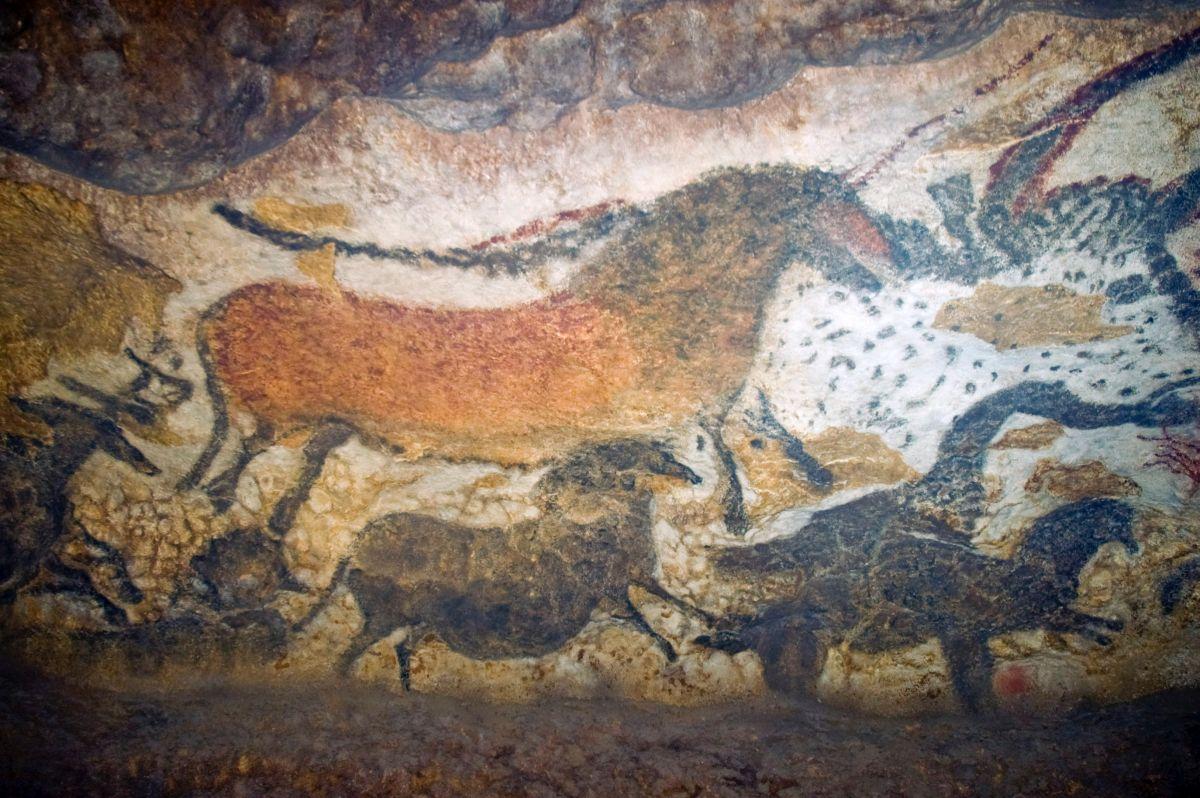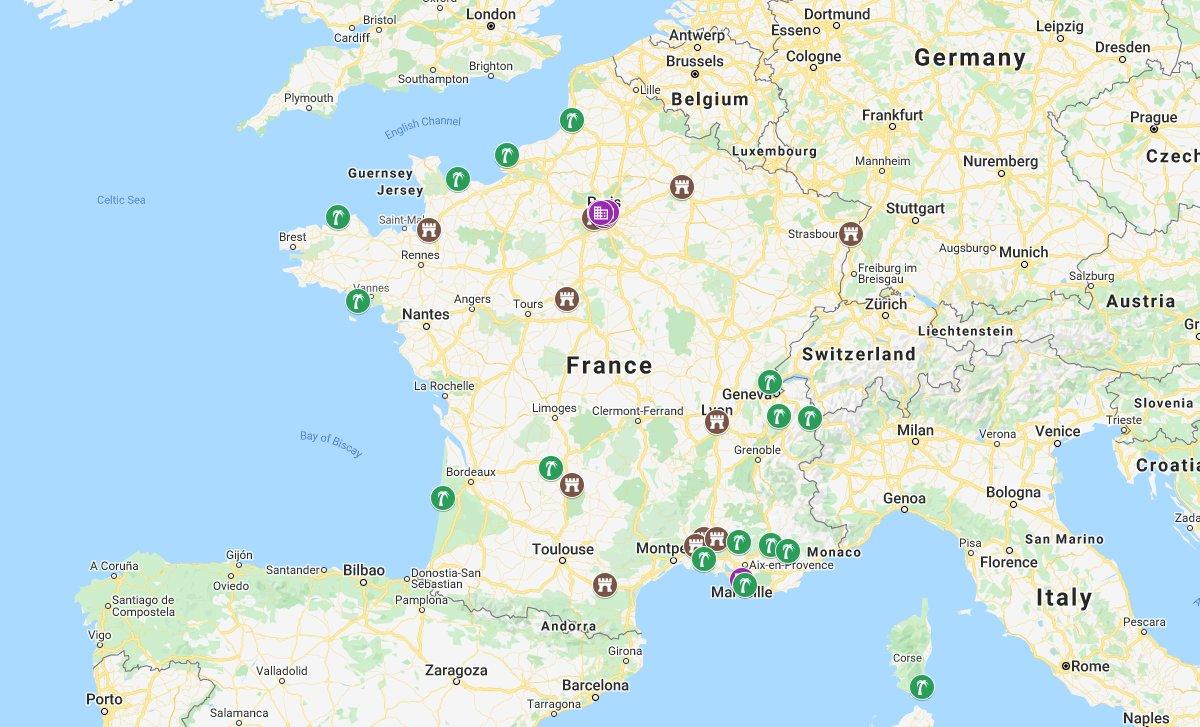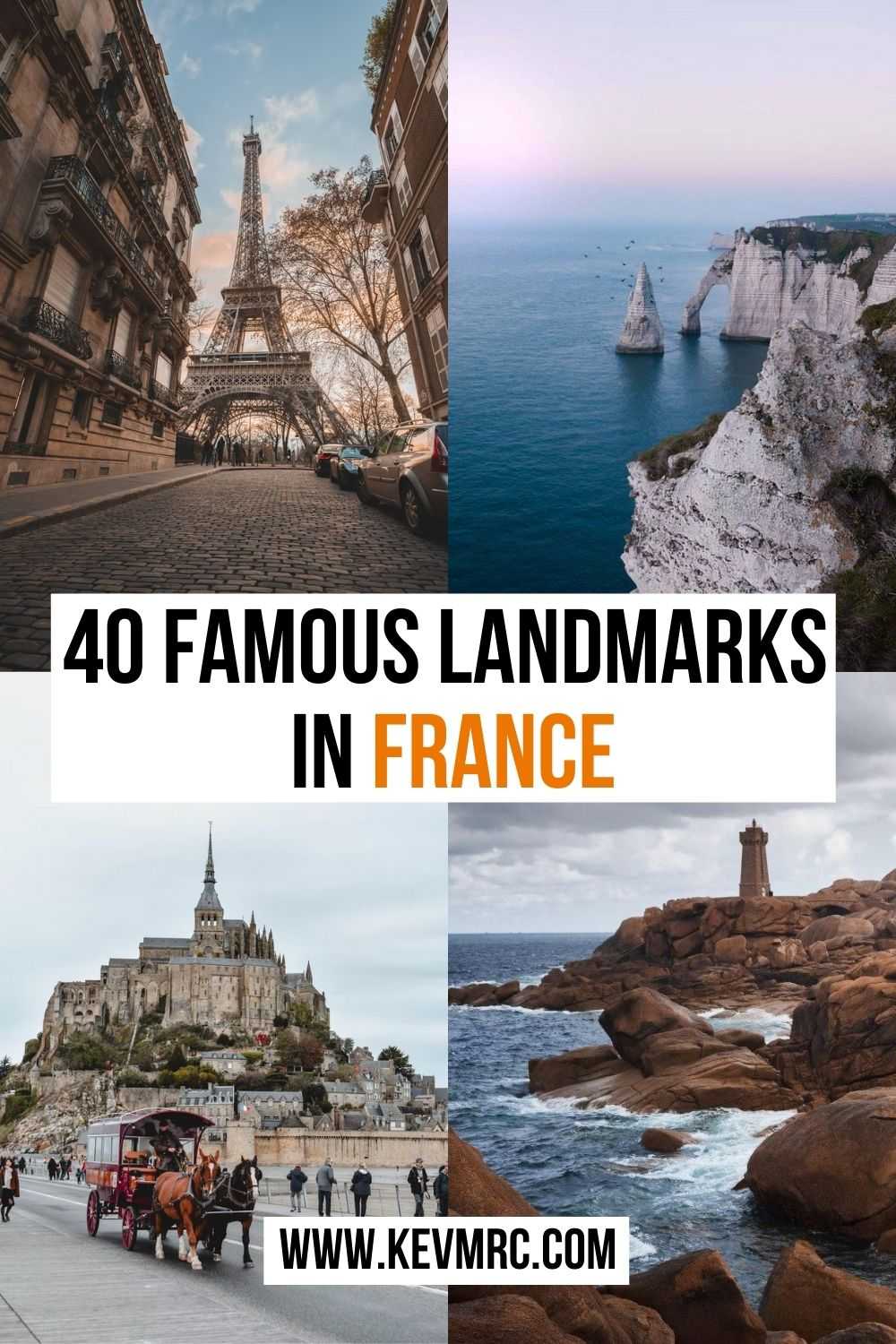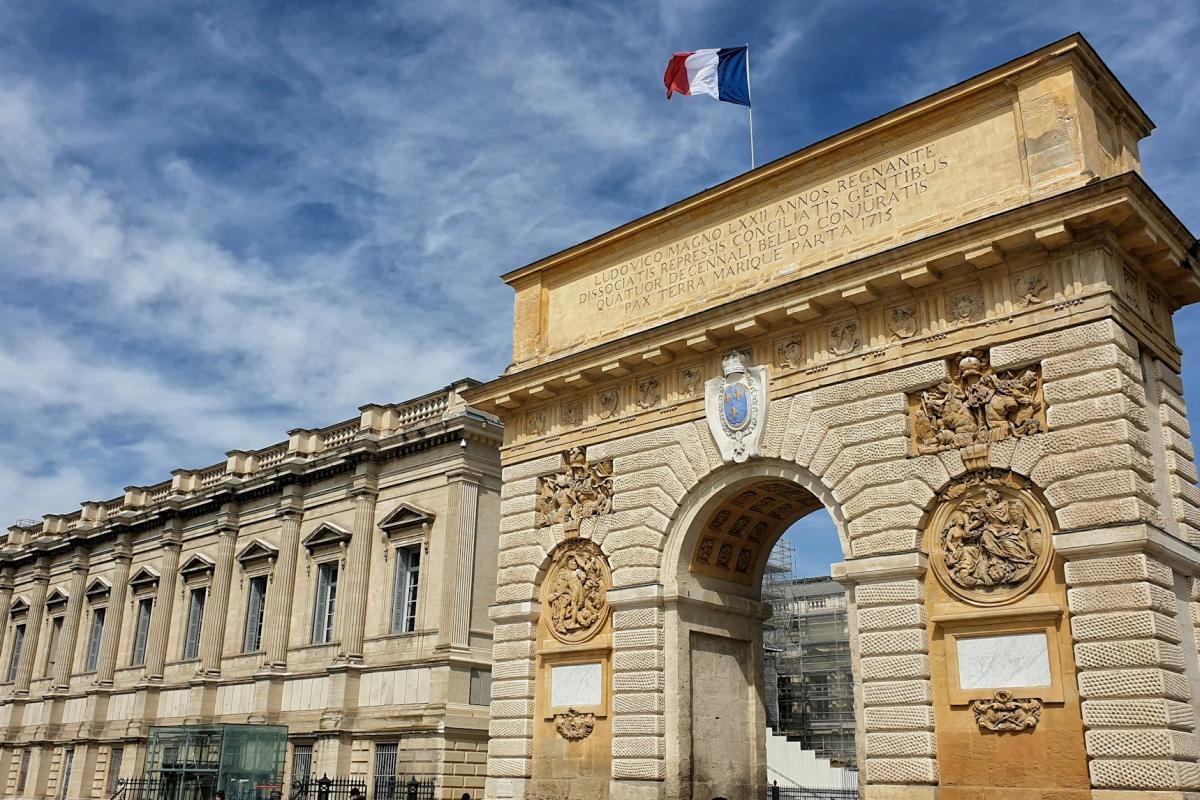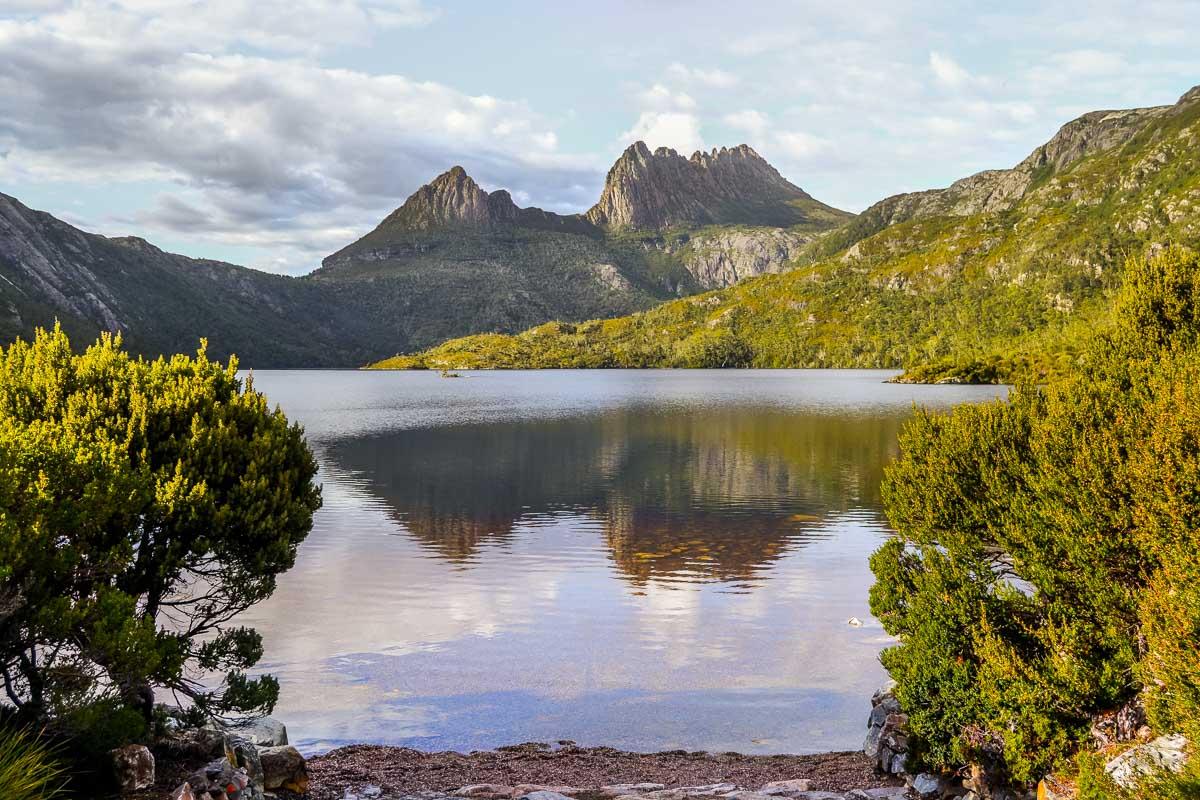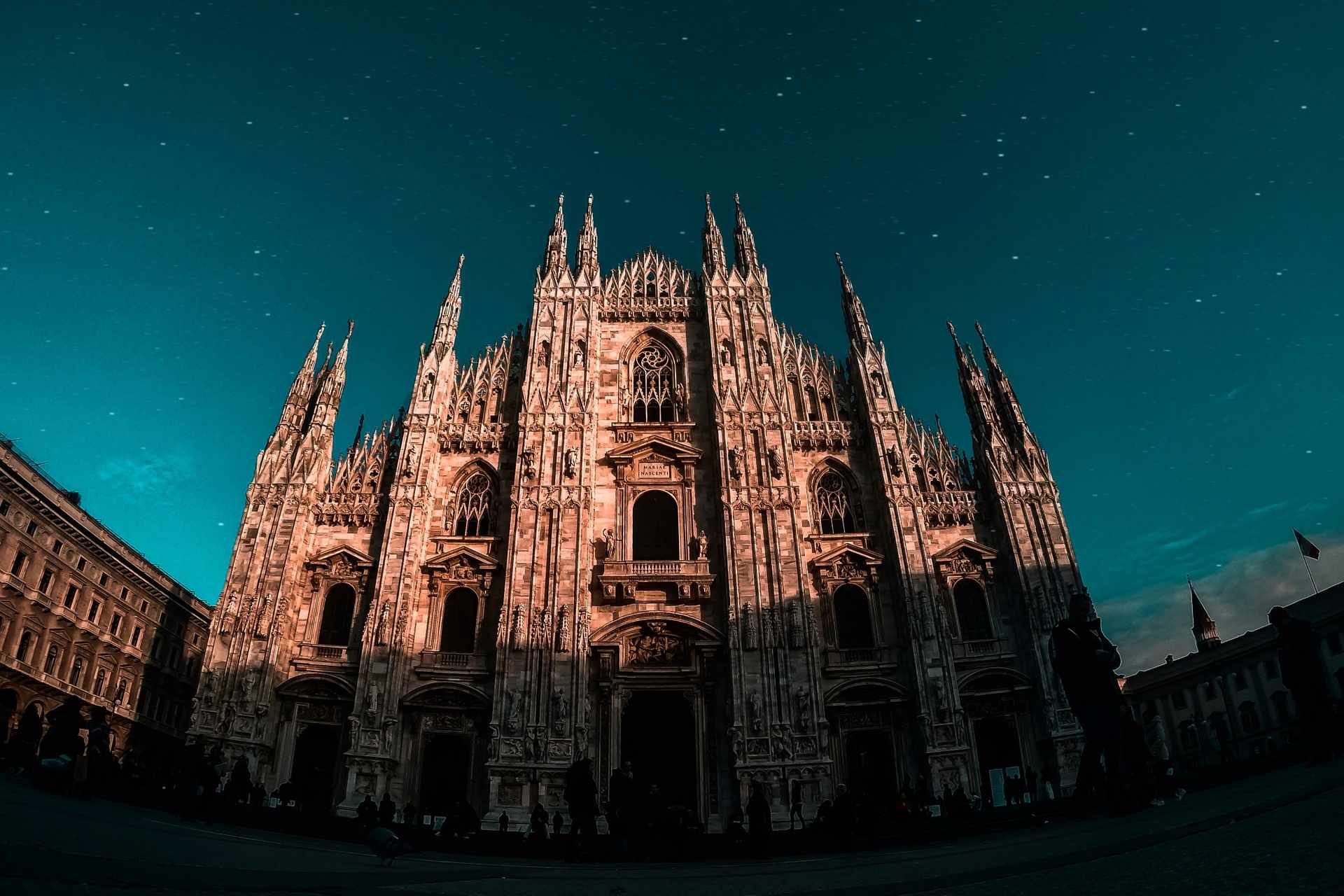40 Famous Landmarks in France (100% worth a visit)
Full of history and beauty, France has been the world’s leading tourist destination since the end of the last century. France is indeed one of the most beautiful countries in the world and each region deserves to be discovered because of its cultural, architectural and culinary diversity.
Aside from Paris top monuments, France has mountains, forests, beaches, national parks, volcanoes, picturesque villages… A variety of unique places, each one more incredible than the next. Whether in the north, south, east, west or center of France, the richness of the territory is everywhere.
Wondering what are the famous landmarks in France?
We couldn’t list them all as there’s so many, but here’s a selection of 40 of the most famous France landmarks!
Full List of the 40 Famous France Landmarks
We can divide the famous French landmarks in 3 main categories: the historical monuments, the buildings and the natural wonders.
🏛 Famous French monuments:
- Eiffel Tower
- Louvre Museum
- Opera Garnier
- Arc de Triomphe
- Notre Dame Cathedral
- Sacré-Coeur
- Versailles Palace
- Loire Valley Castles
- Mont Saint-Michel
- Reims Cathedral
- Strasbourg Cathedral
- Basilica of Notre-Dame de Fourvière
- Pont du Gard
- Amphitheater of Nîmes
- Pope’s Palace
- Notre-Dame de la Garde Basilica
- Carcassonne
- Rocamadour
🏢 Famous buildings in France:
- Montparnasse Tower
- Pompidou Center
- Grande Arche de la Défense
- Philharmonie de Paris
- Louis Vuitton Foundation
- MUCEM
🏔Famous natural landmarks in France:
- Lake Annecy
- Jura Lakes & Waterfalls
- Mont Blanc
- Lavender Fields of Provence
- Verdon Gorges
- Calanques National Park
- The Ochre of Roussillon
- Camargue
- Dune du Pilat
- Lascaux Caves
- Carnac Standing Stones
- Côte de Granit Rose
- D-day Landing Sites
- Etretat
- Baie de Somme
- Corsica Beaches
So, here’s the full list of the 40 famous landmarks France has to offer. To learn more about each of these landmarks, keep reading below 👇
Famous Monuments of France
As you know, France is mostly popular for having the world’s greatest monuments. And you know some of them for sure! But France isn’t limited to Paris, there are lots of wonderful monuments to discover in every corner of the country.
Let’s discover 18 of the most famous France monuments! 🔥
1. Eiffel Tower
We couldn’t start this post with another monument than this one: the Eiffel Tower! Indeed, the Eiffel Tower is to Paris what the Statue of Liberty is to New York and what Big Ben is to London: the ultimate France landmark and one of the most visited monument in the world.
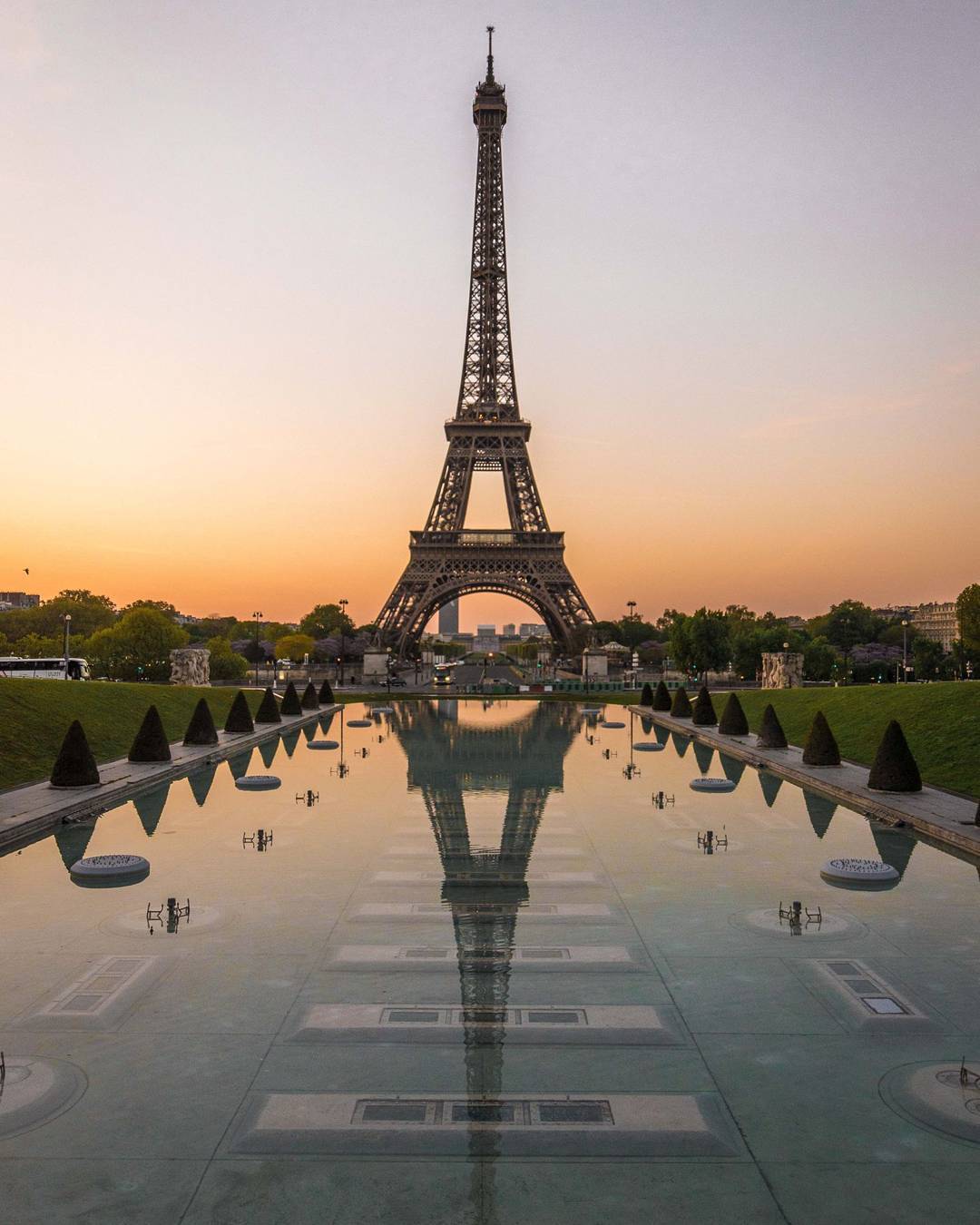
Rising to a height of 324 meters, it was built by French engineer Gustave Eiffel for the 1889 World’s Fair and also commemorates the centenary of the French Revolution.
When strolling through in Paris, you’ll always have different angles and views of the Eiffel Tower, all stunning. It’s certainly the most beautiful at night, when it lights up for 5 minutes every hour from dusk to 1am. But the tower is also incredible from the inside: whether you climb it by elevator or on foot, each floor offers different but breathtaking views of all of Paris.
2. Louvre Museum
The Louvre isn’t only the best art museum in the world but also the most visited. With 210,000 m² of exhibits where you can find works from almost every civilization in the world, it’s also the largest museum in the world.
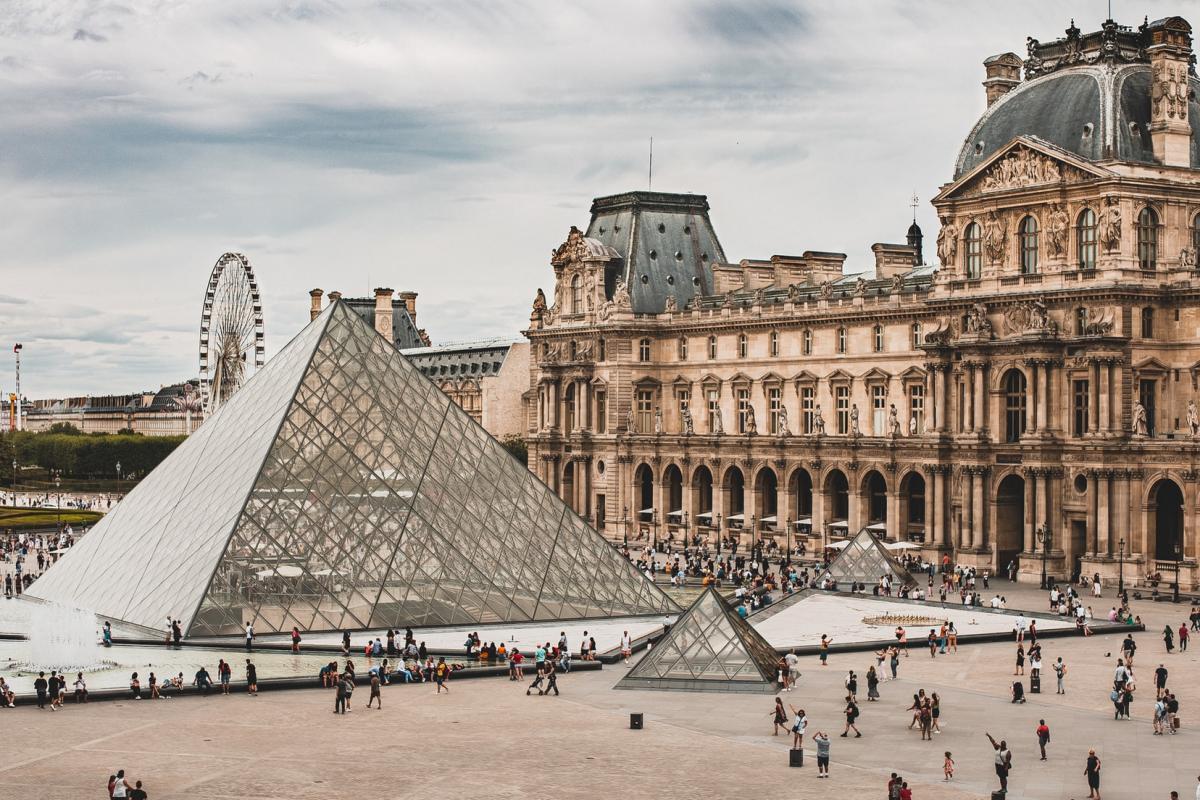
Among the 35,000 works, the most popular are the Mona Lisa, the Venus de Milo and the Victory of Samothrace. Housed in the former royal palace in Paris, the Louvre has existed for 8 centuries and has been influenced by many architectural trends.
The Louvre Museum is so big that you have to come back more than once to discover all its secrets. Don’t miss its glass pyramid, magnificent from the inside and the outside!
3. Opera Garnier
Classified as a historical monument, the Opéra Garnier, also called Palais Garnier, is a must to add to your list of things to do if you come to visit Paris.
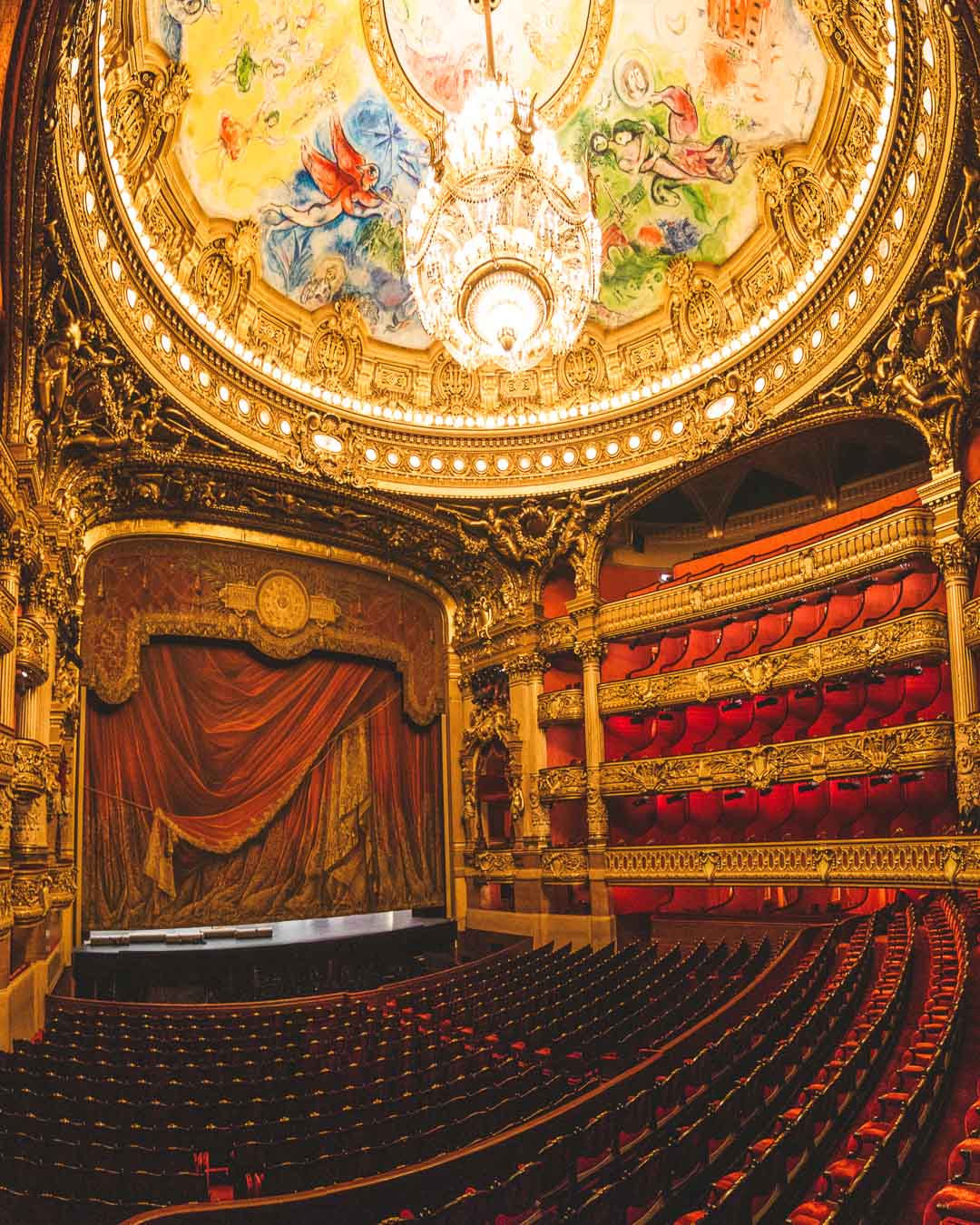
Built by Charles Garnier under Emperor Napoleon III in 1875, this massive opera house is a masterpiece of the 19th century theatrical architecture. Since then, the Palais Garnier became a symbol of luxury and a major institution of French culture.
Located close to the Louvre and Place Vendôme, visitors will be amazed by its stunning facade, its huge staircase and of course by its majestic auditorium with its 220 m² ceiling canvas painted by artist Chagall.
4. Arc de Triomphe
Located on the Place de l’Etoile above the world’s most beautiful avenue, the Champs-Elysées, the Arc de Triomphe is a major symbol of Paris and one of the most visited monuments.
Built in 1836 under Napoleon I following his victory at Austerlitz, the Arc de Triomphe also hosts the grave of the Unknown Soldier in tribute to the 1.3 million French soldiers who died during the WWI. Every evening at 6.30pm, the flame is lighted in his honor.
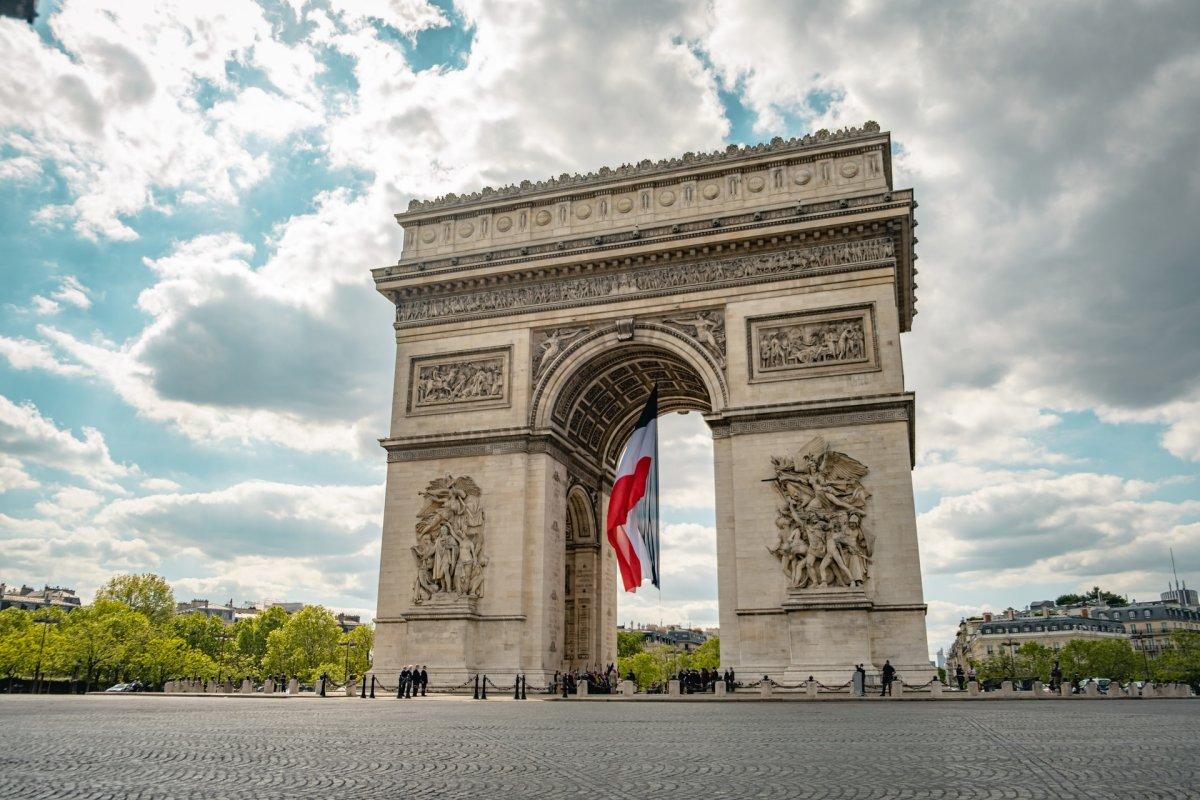
Today, it’s on this square and under the Arc that many French events take place such as the national holiday of July 14th or the ceremony of May 8th commemorating the end of WWII.
If you visit, don’t hesitate to climb the 284 steps that will lead you to the top to discover a wonderful view of the Champs Elysées and the Etoile square.
5. Notre Dame Cathedral
Located on the Ile de la Cité, the Notre-Dame de Paris Cathedral is another must-see symbol of Paris.
Completed in 1345, the construction of the stunning Notre-Dame took 182 years! Napoleon was crowned here, and many kings and queens of France exchanged their wedding vows in this cathedral.
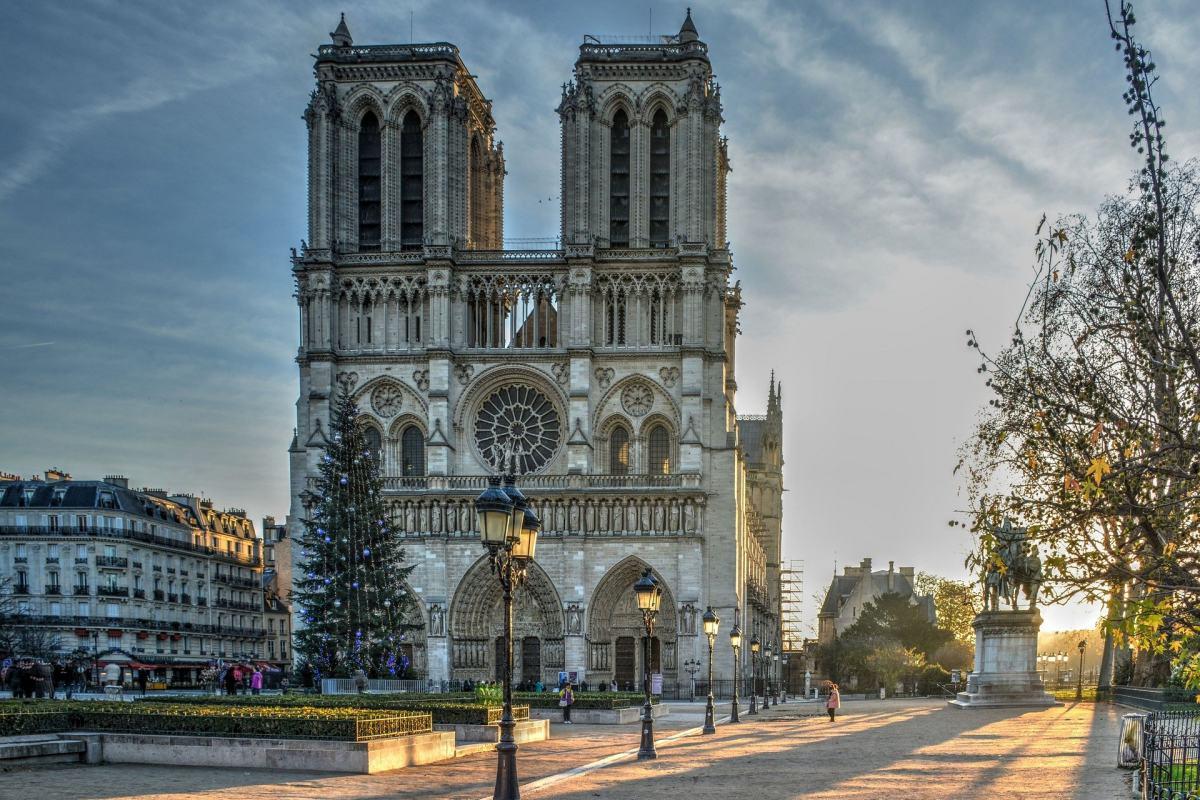
Before the fire occurred in April 2019, it was possible to visit the incredible interior of the Gothic cathedral with its beautiful architectural details, magnificent stained glass windows and rose windows. Visitors could also climb to the roof for the unforgettable panoramic view of Paris, between the gargoyles and the spires.
The cathedral is currently under reconstruction and visitors will undoubtedly be able to rediscover this jewel soon.
6. Sacré-Coeur
Located at the top of the Montmartre hill in the famous eponymous district, the Basilica of the Sacred Heart, known as Sacré-Coeur Basilica, is one of the most iconic monuments of Paris.
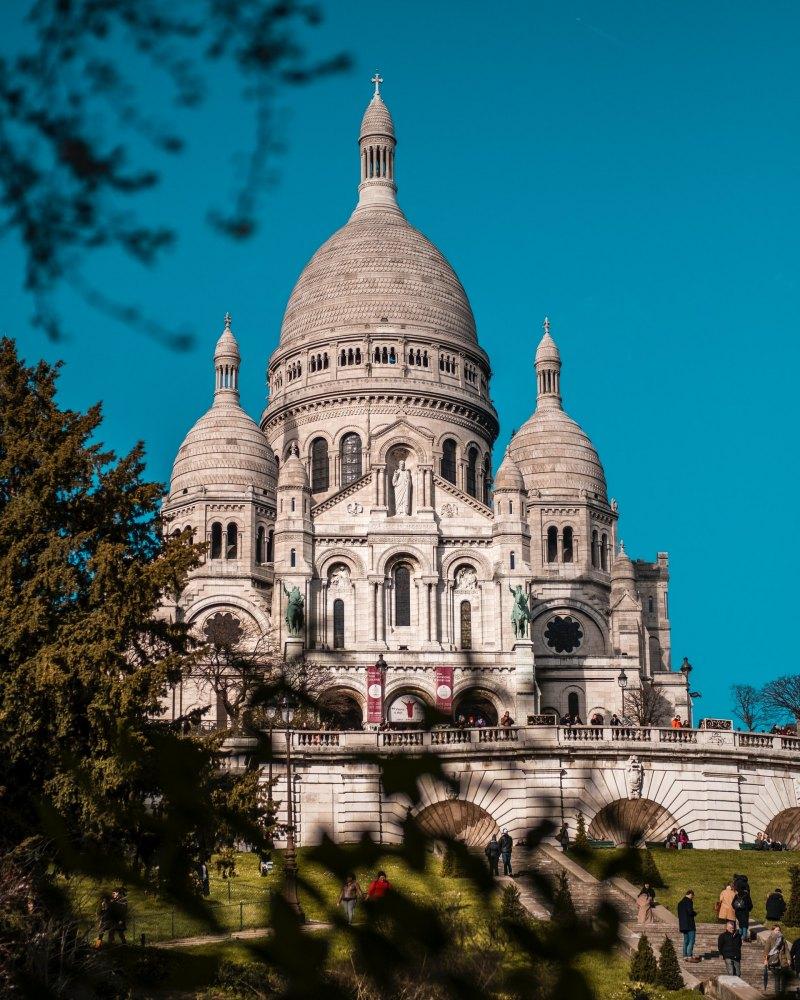
Consecrated in 1919 after WWI, this white castle is special for offering one of the most beautiful panoramic views of the capital city, at 130 meters above ground. The Sacré-Coeur is also quite unique Paris because of its style mixing Romanesque and Byzantine.
Inside, the ceiling is decorated with the largest mosaic in France measuring 480 m². It’s possible to access the dome of the basilica to admire the city from even higher.
7. Versailles Palace
World famous and classified as a UNESCO heritage site, the Château de Versailles is a place that you must visit at least once in your life! Visiting this castle is finding yourself in the heart of French history and being mind-blowed by so much beauty and finesse.
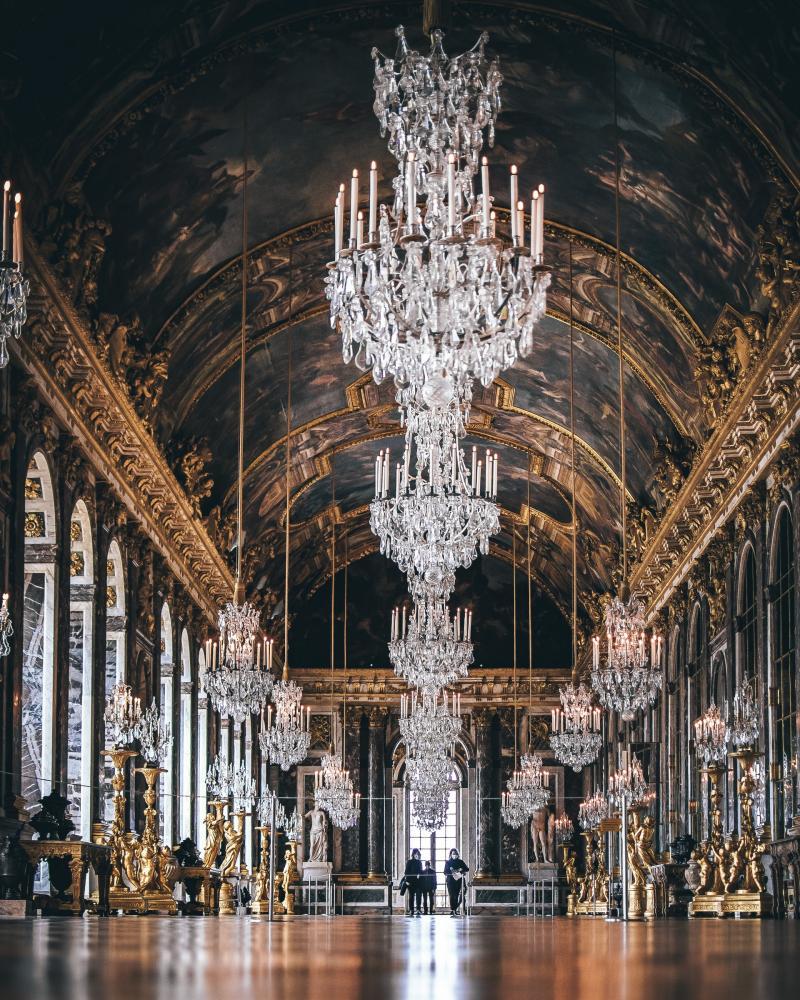
Located about 35 minutes drive from Paris, the Versailles Palace was built progressively. At first, it was only a hunting lodge for the king of France. From 1623 onwards, many extensions were made, the French gardens were created and the castle became the royal residence with Louis XIV until the French revolution in 1789.
Today, this castle is one of the most renowned monuments of the world heritage: the Hall of Mirrors, the royal apartments, the Chapel and the Royal Opera House make it an exceptional landmark.
8. Loire Valley Castles
Located about 2 hours drive from Paris, the Chateaux of the Loire Valley are one of the most popular tourist destinations in France. It’s a collection of exceptional French castles located in the Loire region near the city of Orleans.
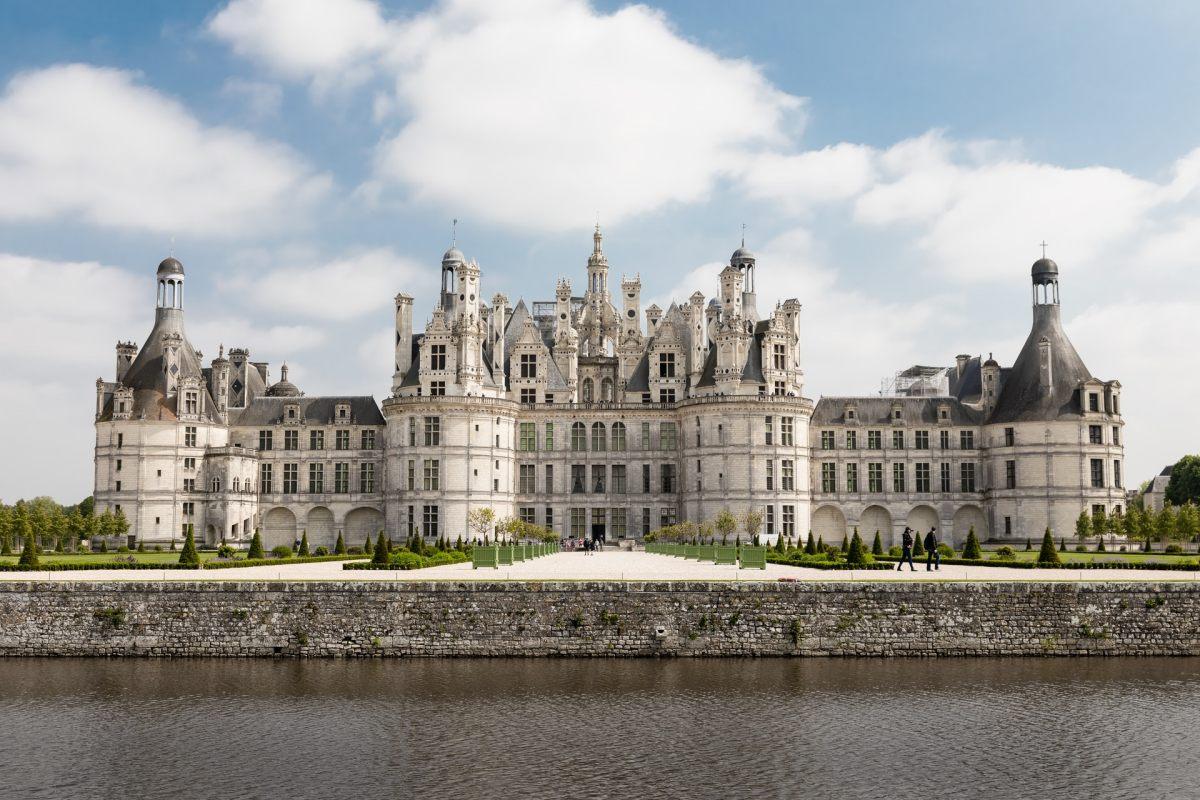
Built between the 15th and 16th centuries during the Renaissance, the Loire Valley Castles include nearly 3,000 castles listed as UNESCO World Heritage Sites, making it the largest concentration of royal and noble castles in the world. Some of them are ancient medieval fortresses dating from the 10th century.
Although you’ll certainly not be able to visit all the castles, some are unmissable: Chambord, Angers, Chenonceau, Saumur, Cheverny and Blois are definitely the best!
9. Mont Saint-Michel
Located in the west of France, the Mont-Saint-Michel is without a doubt one of the most beautiful sites in France and a a must for any itinerary in Normandy. It’s the famous castle that inspired Disney for the creation of Rapunzel’s castle.
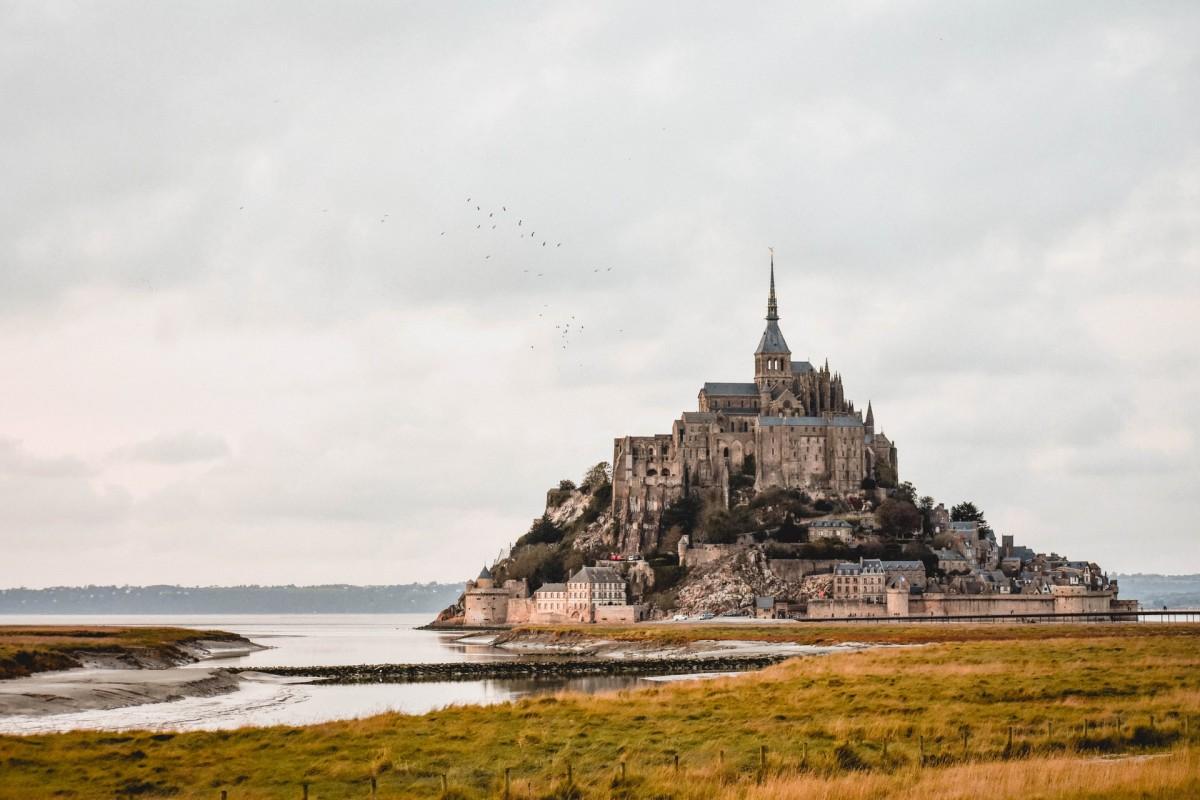
Classified as a UNESCO World Heritage Site, the Mont-Saint-Michel is a village built on a huge rock with an amazing abbey that travelers from all over the world come to discover. Fascinating for its history and architecture, the Mont-Saint-Michel is unique for changing its face throughout the day according to the rhythm of the tides, the clouds, the point of view or whether or not the sheep come and go.
Visitors can easily access the village through a bridge. The more adventurous can try to discover the bay on foot, but with a guide only. Indeed, it’s here that the tides have the greatest amplitude in Europe and it’s easy to be trapped by the waters or in the quicksand.
10. Reims Cathedral
Even bigger than Notre-Dame de Paris, the Reims Cathedral is an architectural masterpiece not to be missed if you’re on a road trip in France. Located in the eastern part of France about 1h train from Paris, the Cathedral is listed as a UNESCO World Heritage Site.
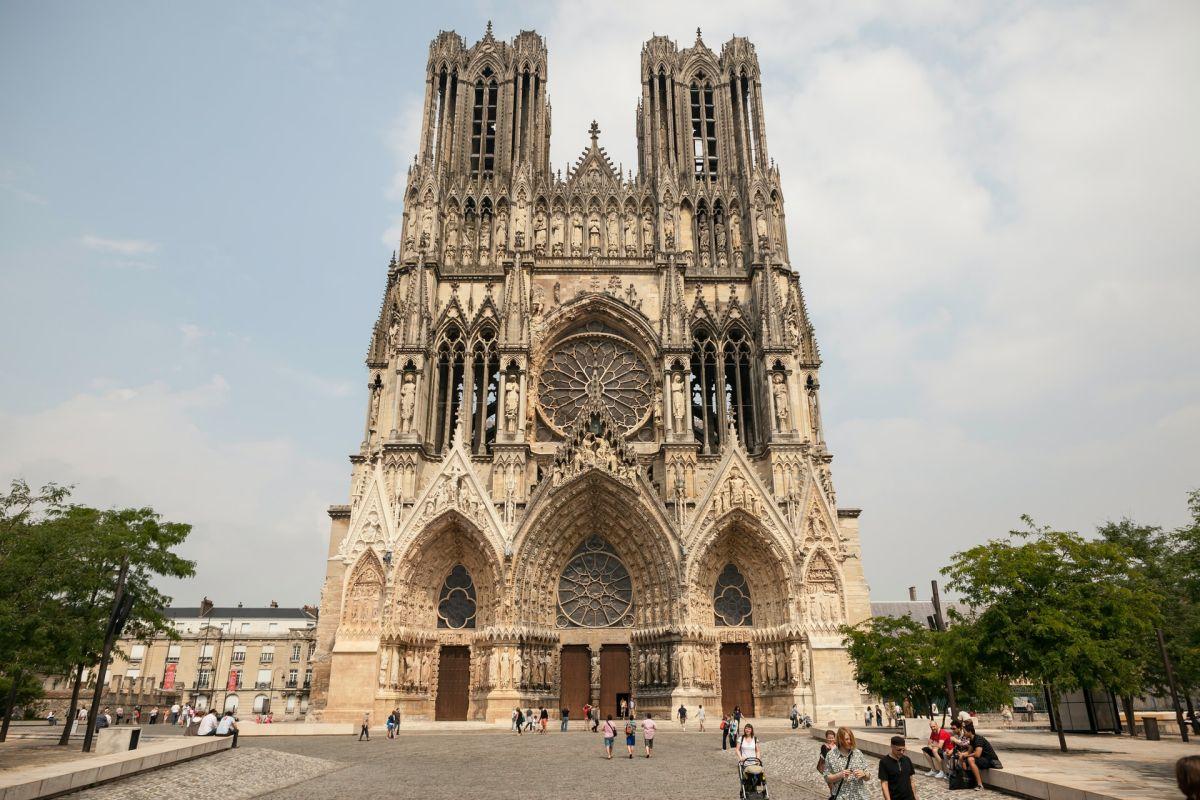
This 13th century gothic style building is mainly known for having been the place where most of the kings of France were crowned, but also for its huge collection of statues.
Whether you see its exterior or visit the interior, you’ll be more than blown away by the beauty of the building and its decorations.
11. Strasbourg Cathedral
Strasbourg Cathedral is located in the city of Strasbourg in the Alsace region, only a few kilometers from the German border. Also known as Notre-Dame de Strasbourg, it’s one of the most impressive and famous monuments in France.
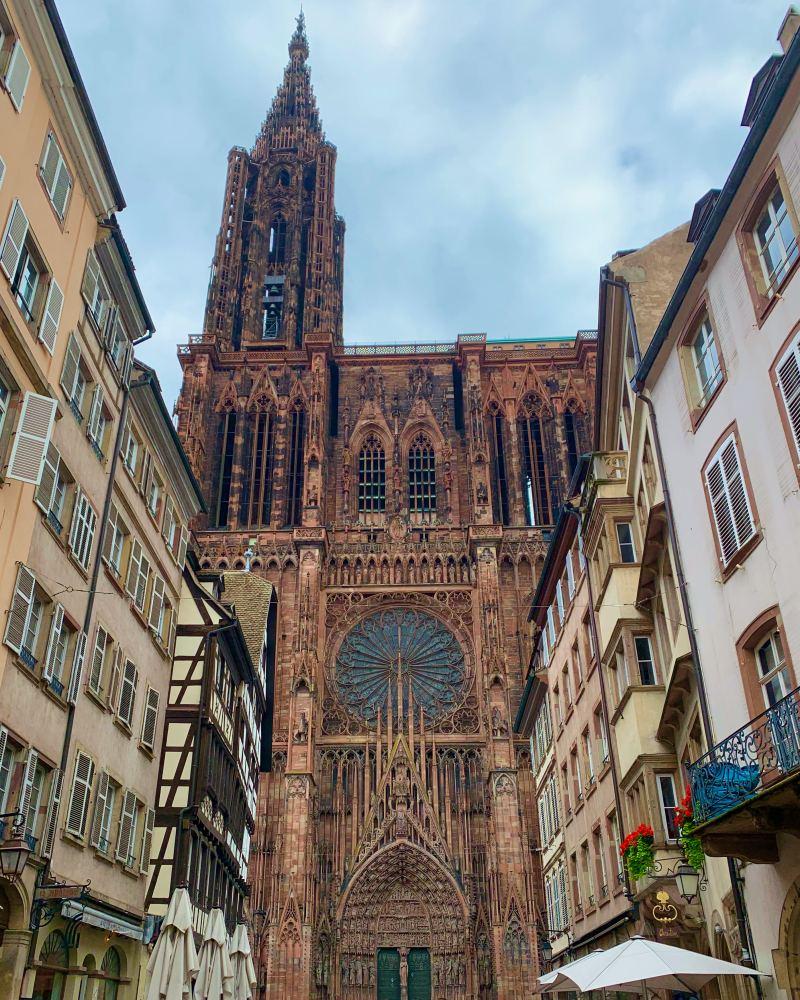
With its 142 meters height at the tip of its spire, it’s the second highest cathedral in France behind Notre-Dame de Paris. Until the 19th century, the Strasbourg Cathedral was the highest Christian building in the world. Built in pink sandstone in 1439, its construction took 3 centuries!
The façade of this gothic masterpiece is unique by its color and its incredible size. Inside, the cathedral has magnificent stained glass windows and a huge astronomical clock dating from the 16th century. Don’t hesitate to climb on its platform at 330 meters to discover a breathtaking view on the Vosges ranges, the picturesque roofs of Strasbourg and the Black Forest.
12. Basilica of Notre-Dame de Fourvière
The Basilica of Notre Dame de Fourvière sits atop the Fourvière hill in Lyon, the 3rd largest city in France. Completed in 1896, the basilica overlooking the entire city is an iconic monument in France.
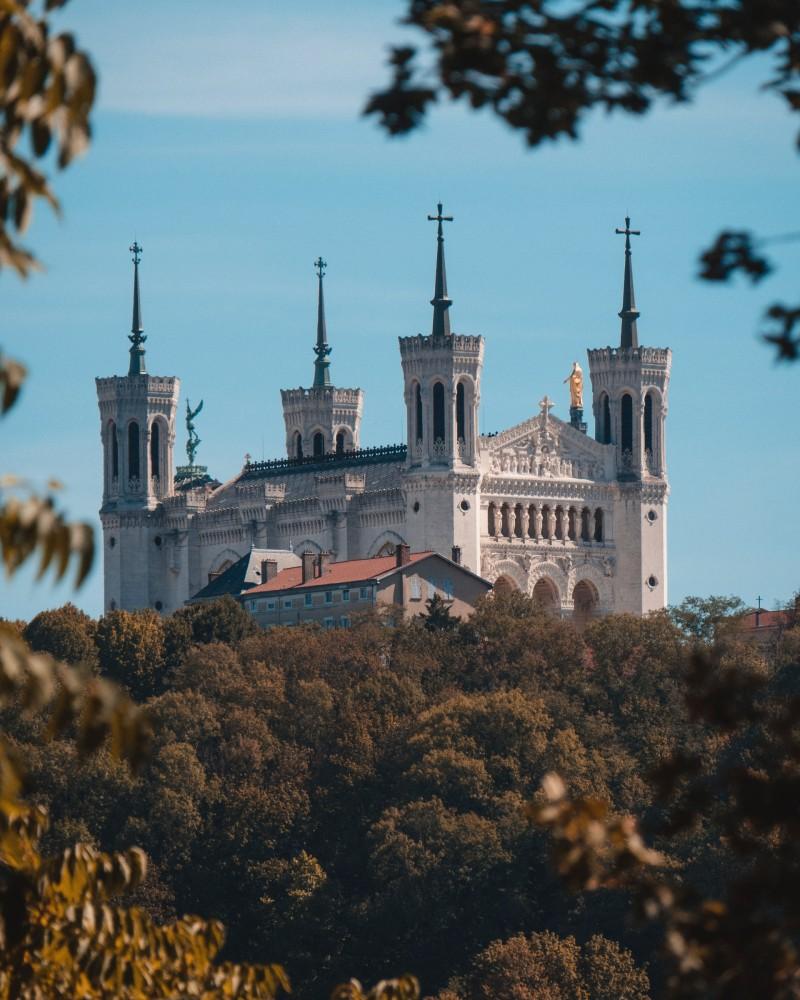
Mixing Romanesque and Byzantine styles, the religious building is richly decorated inside and out: its white facade is magnificent, and its interior includes golden mosaics representing the history of the Virgin in the French history and the Church.
From the esplanade of the basilica, visitors can enjoy a panoramic view of the whole city, a must-see in any Lyon itinerary.
Read more: Best things to do in Lyon
13. Pont du Gard
Located in the south of France near the city of Nimes, the Pont du Gard is one of the most important tourist attractions in France. Built in the 1st century AD, this bridge has a history of more than 40 centuries!
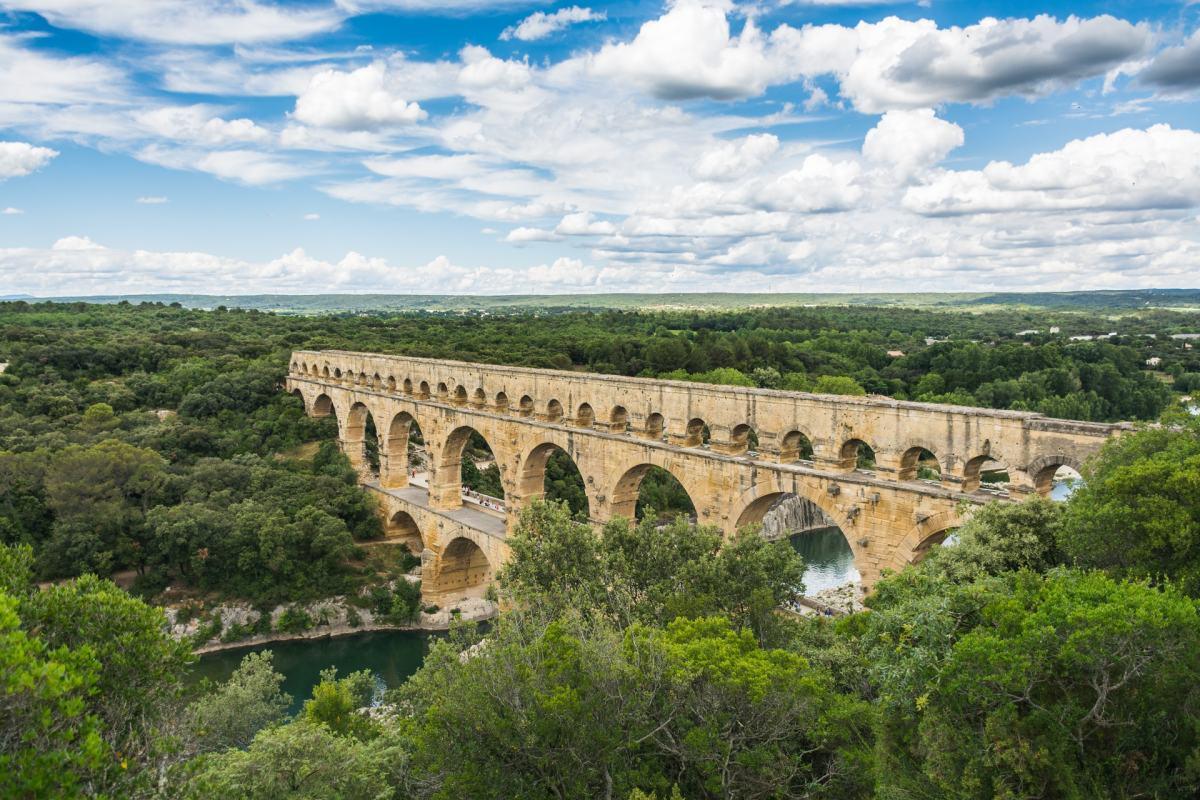
Composed of 3 levels, this aqueduct initially built to carry water from Uzès to Nîmes is a real technical feat. But the monument that we know today is only a part of the aqueduct, the rest having been destroyed during its long history.
In front of such a monument, all the visitors are impressed so much they feel tiny. This monument, which is listed as a UNESCO World Heritage Site, is indeed of incredible dimensions.
14. Arena of Nîmes
Located in the heart of the historic city center of Nîmes, the Arena of Nîmes is one of the best preserved Roman amphitheaters in the world and a must-see of any trip to the South of France.
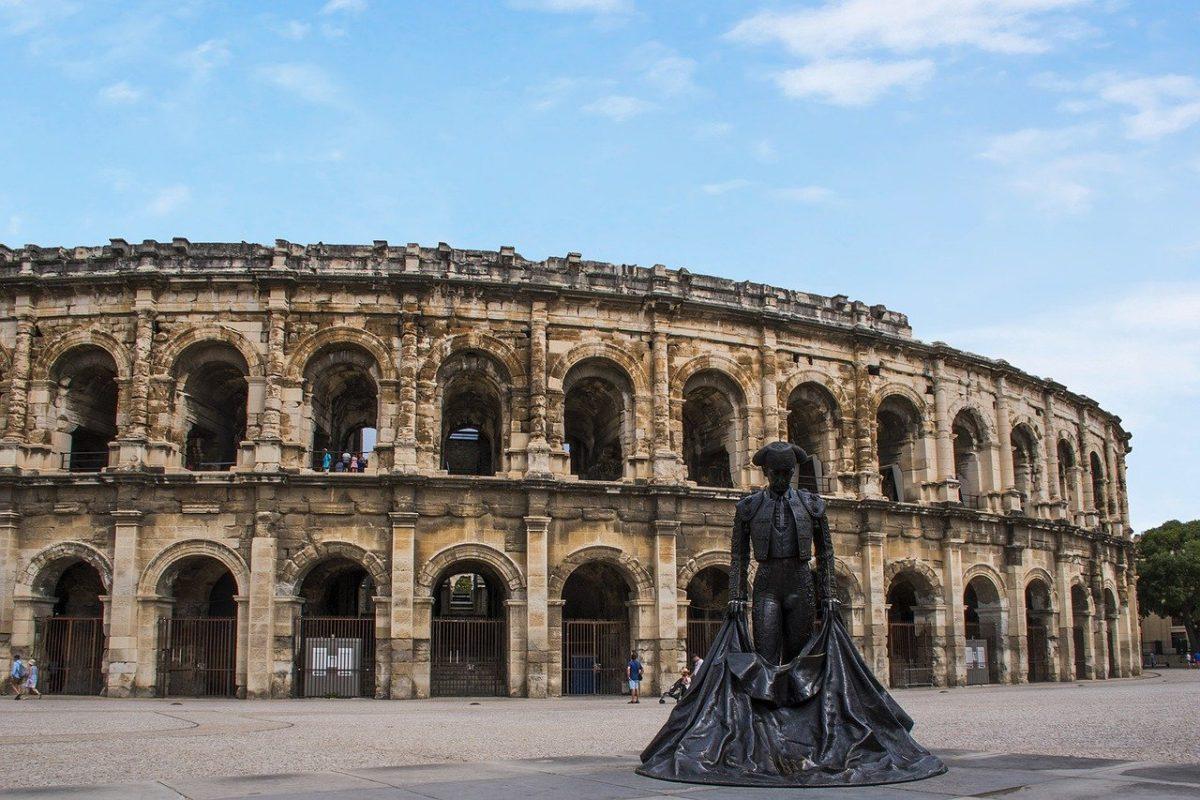
This perfectly symmetrical amphitheater demonstrates the degree of perfection achieved by Roman engineers in the design and construction of this type of building.
Built in the 1st century, it has been used as a stage for gladiator and animal fights for a long time. Also called the Amphitheatre of Nîmes, this iconic monument now hosts many shows and events, such as corridas, the Nîmes Festival or performances of the Great Roman Games.
15. Pope’s Palace
With more than 600,000 visitors per year, the Pope’s Palace is one of the 10 most visited monuments in France. It’s also the largest Gothic building ever built of the Middle Ages.
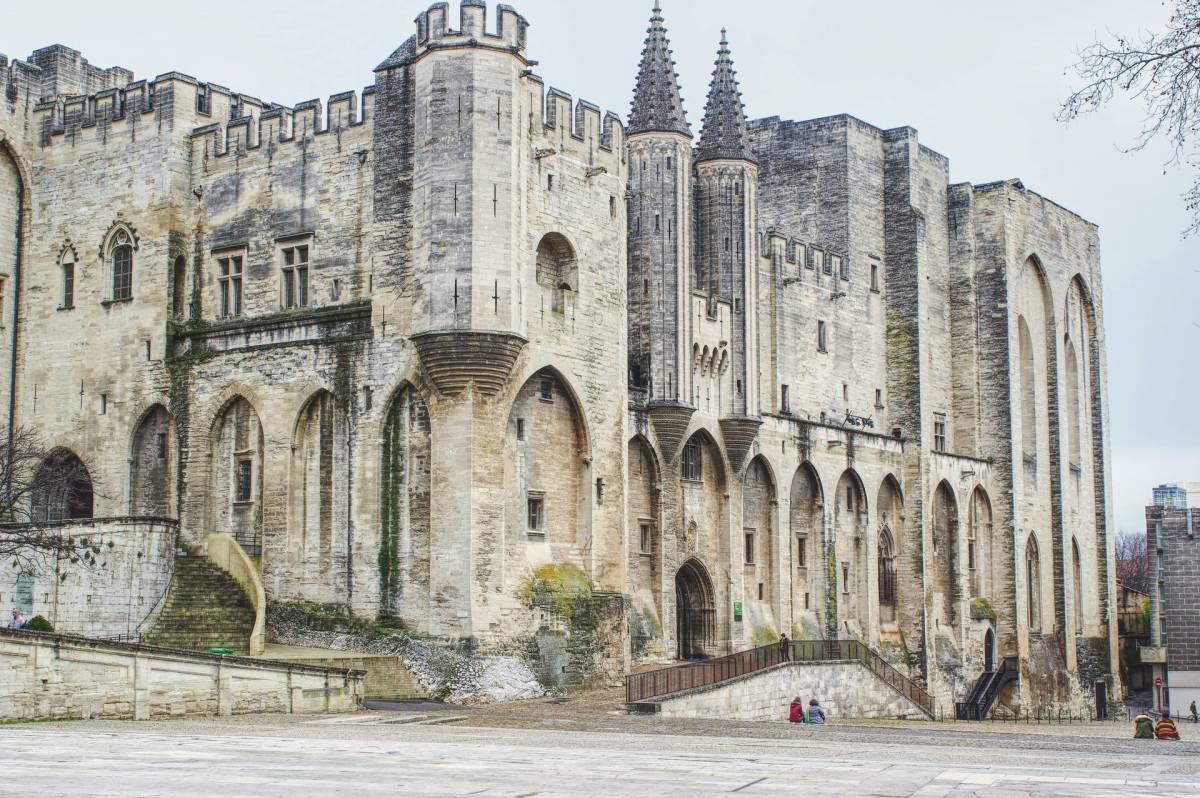
Located in the city of Avignon in the south of France, this UNESCO World Heritage Site completed in 1352 served as a fortress and residence for the popes until 1417.
Today, many cultural and artistic events are organized there such as exhibitions, concerts, and even some performances during the Avignon festival in the main courtyard of the palace.
16. Notre-Dame de la Garde Basilica
Notre-Dame de la Garde is a Catholic basilica overlooking the city of Marseille, perched 150 meters high on the hill of La Garde. It’s the symbol of France’s second largest city and a major France monument.
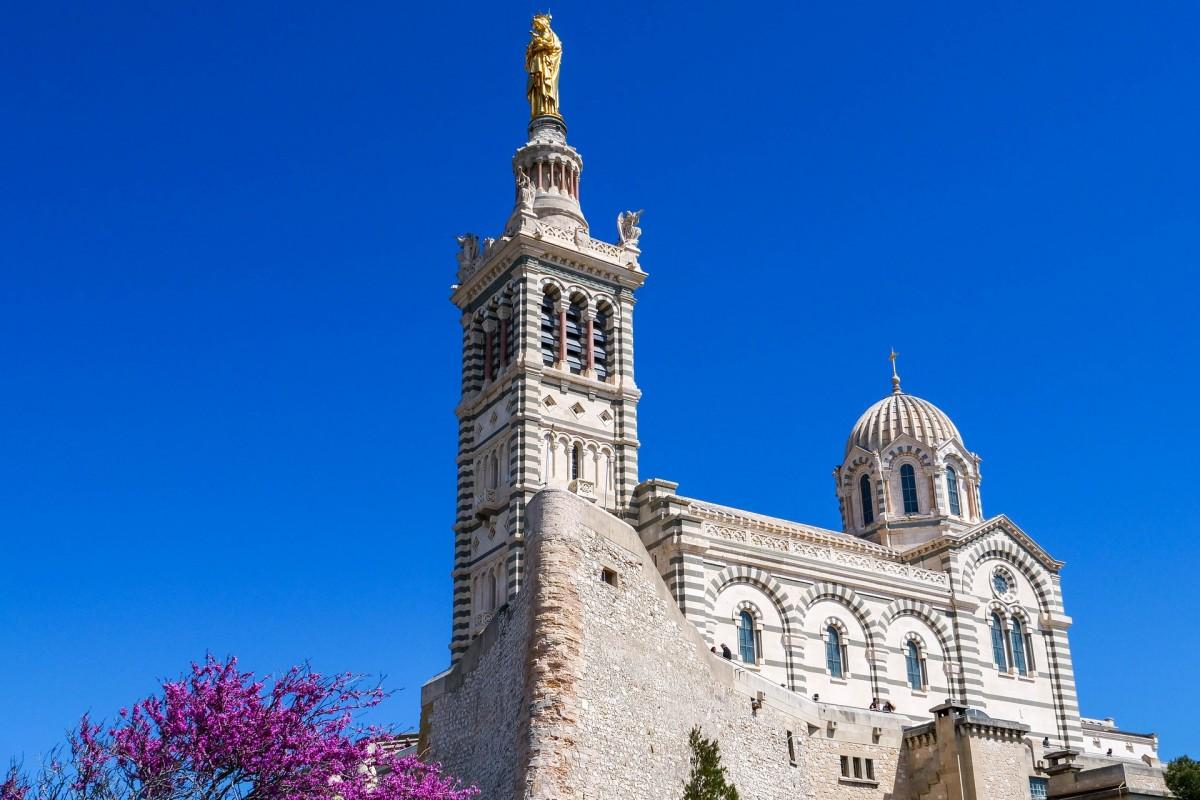
The basilica dates back to the 13th century with a chapel dedicated to the Virgin Mary, but as the pilgrims were more and more numerous, a second chapel was built in the 15th century. It has been extended many times since then, including fortifications in the 16th century and neo-Byzantine style additions in the 19th century.
Today, the basilica is a must-see in of Marseille. Its white and red marble facade, the golden statue of the Virgin Mary and its Byzantine mosaics inside make it an exceptional monument. Visitors can also admire a stunning 360° view on the whole city from its terraces.
17. Carcassonne
Located near the Pyrenees between the cities of Toulouse and Montpellier in the south of France, the medieval town of Carcassonne is a UNESCO World Heritage Site that will make you time travel.
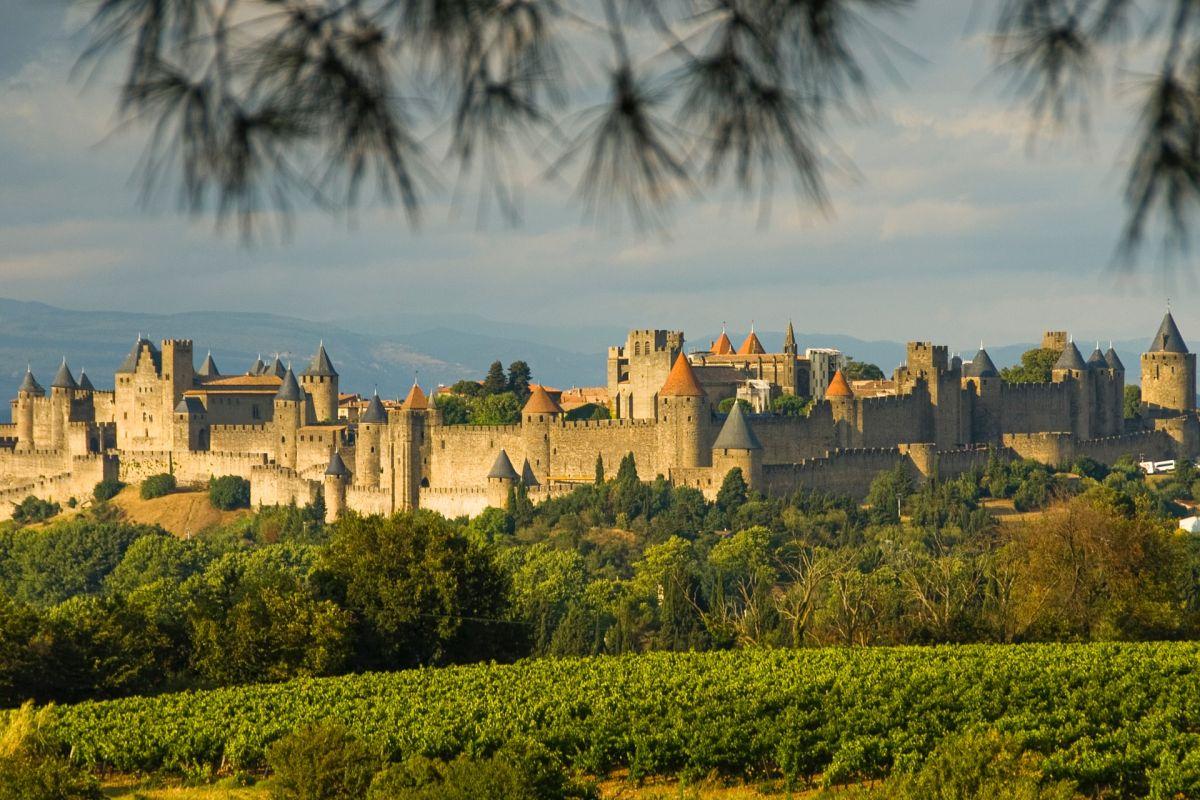
Carcassonne is the largest and best preserved medieval fortress in Europe with a 2, 000 year old history. Surrounded by 2 walls with 52 towers and 3 km of walls, this jewel also has a castle, a basilica, and many other treasures to discover.
Ranked among the 5 most visited cities in France, tourists love to stroll along the walls offering a wonderful view of the Aude Valley and the Lower Town. At night, the illumination of the walls and the city is magical!
18. Rocamadour
Located in the southeast of France in the Dordogne Valley, the village of Rocamadour is perched on a cliff with a magnificent medieval city and a famous French landmark.
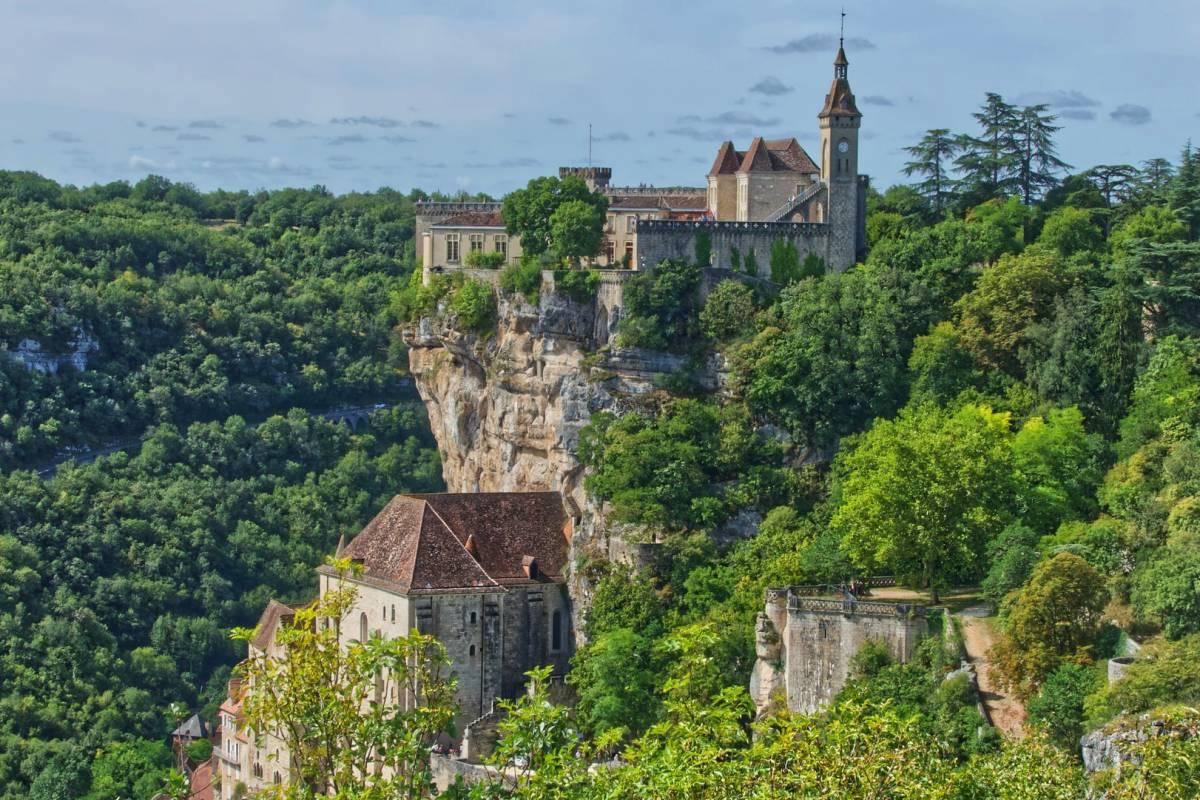
Listed as a UNESCO World Heritage Site, Rocamadour has been an important Christian landmark since the Middle Ages as it’s a major stop on the pilgrimage route to Santiago de Compostela. The village is a sanctuary for both the Black Madonna and for the beliefs and legends of everyone.
This village has the particularity to be vertical: to reach the medieval city, visitors have to climb the 216 steps of the Grand Escalier (“Big Staircase”)! An elevator is still available to go up to the sanctuary for those who can’t climb up.
Famous Buildings in France
Now that we’ve seen the famous monuments of France, let’s discover the buildings! Unlike monuments, buildings don’t necessarily have a strong historical background nor a memorial dimension.
Let’s discover together 6 of the most famous buildings of France! 🚀
19. Montparnasse Tower
Located east of Paris in the 15th arrondissement, the Montparnasse Tower is the tallest building in the capital city after the Eiffel Tower and among the most famous French buildings.
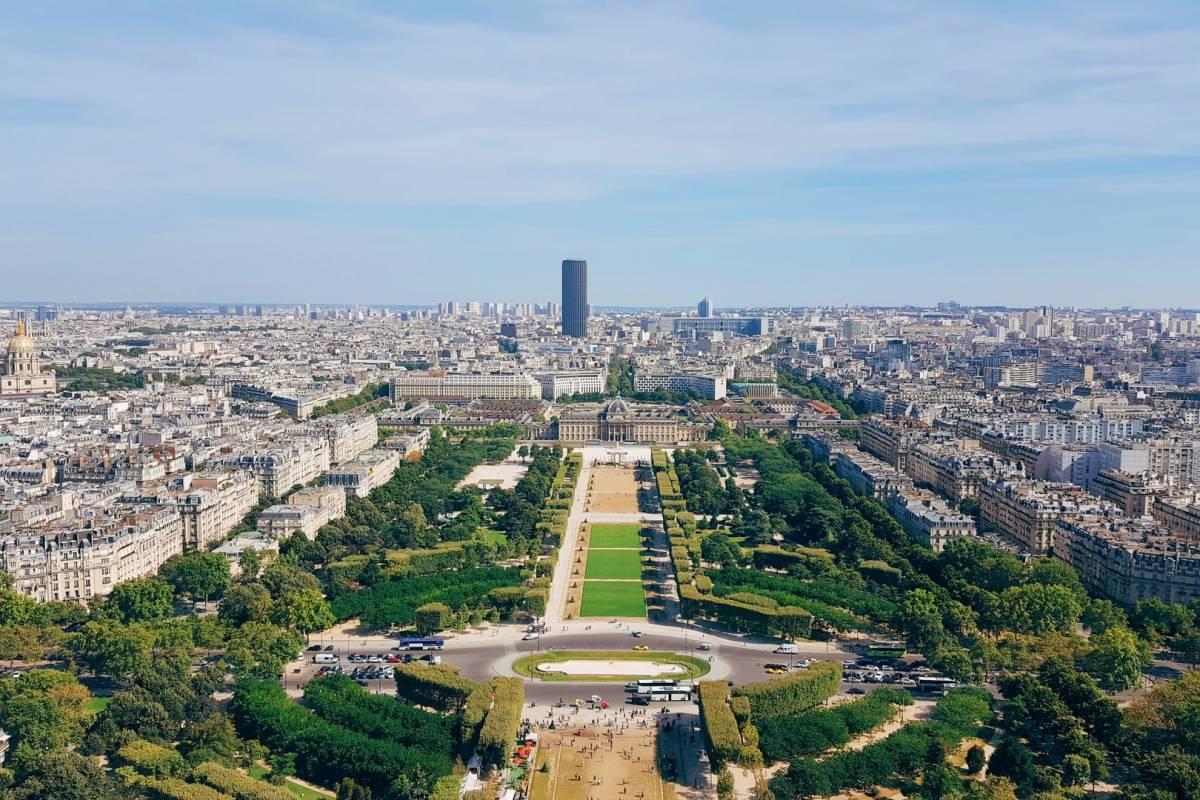
View of Montparnasse Tower from the Eiffel tower
Built between 1969 and 1973, the Montparnasse Tower has 58 floors, 25 elevators, and a total area of 90,000 m². Although the entire skyscraper is intended for corporate offices, the 56th and 58th floors are open to the public.
Just like the London Eye in London or the Empire State Building in New York, the Montparnasse Tower has an observatory on the 58th floor offering an absolutely unique view of Paris and its monuments.
20. Pompidou Centre
Completed in 1977, the the Georges Pompidou Art and Culture Foundation, also known as the “Centre Pompidou” or “Beaubourg”, is located between the Marais and Les Halles districts, in the heart of Paris.
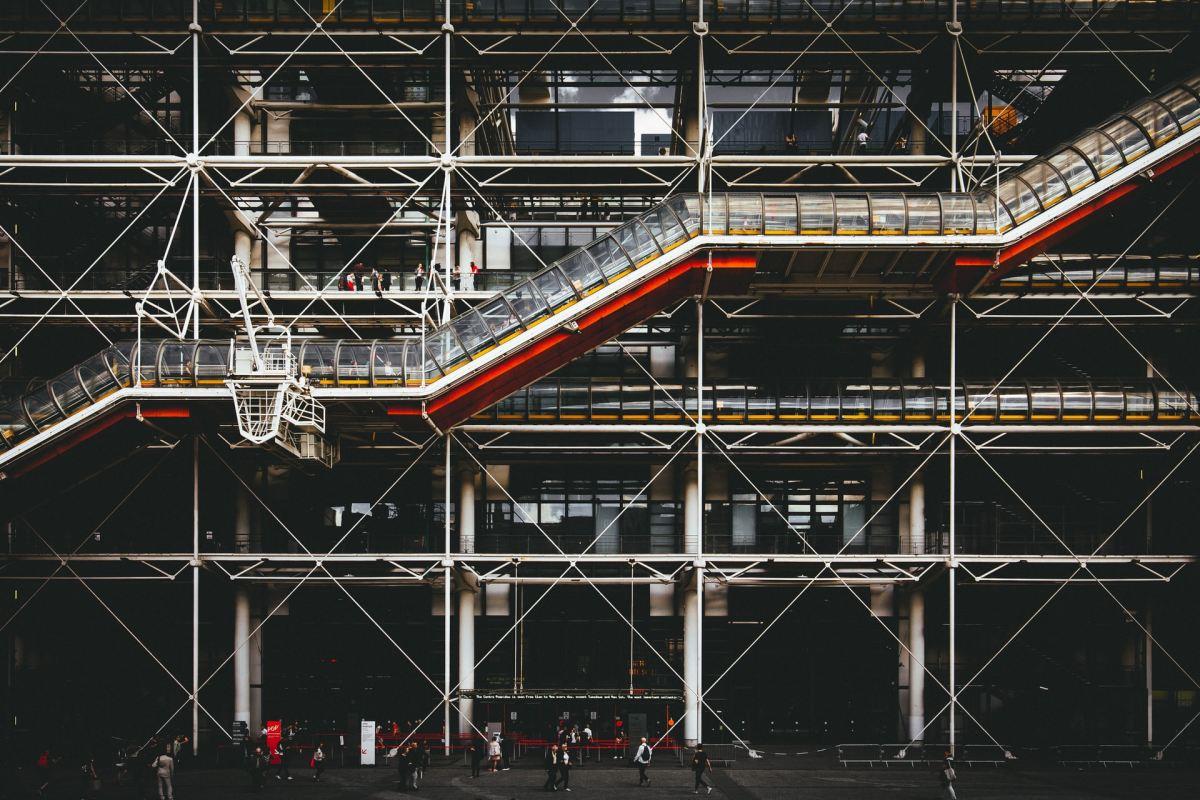
With its exposed framework, exterior escalators and colored pipes, the building has a very distinctive style and is considered an architectural marvel of the 20th century.
The Pompidou Centre has the 3rd largest collection of modern and contemporary art in the world with over 100,000 works by 6,400 artists from around the world, temporary and permanent exhibitions, theaters, cinema and the first public reading library in Europe.
21. Grande Arche de la Défense
La Grande Arche is located in the business district of La Défense, very close to Paris. This building is part of the Paris skyline and is aligned with some of the most symbolic monuments of the capital such as the Louvre, the Place de la Concorde, the Champs Elysées and the Arc de Triomphe.
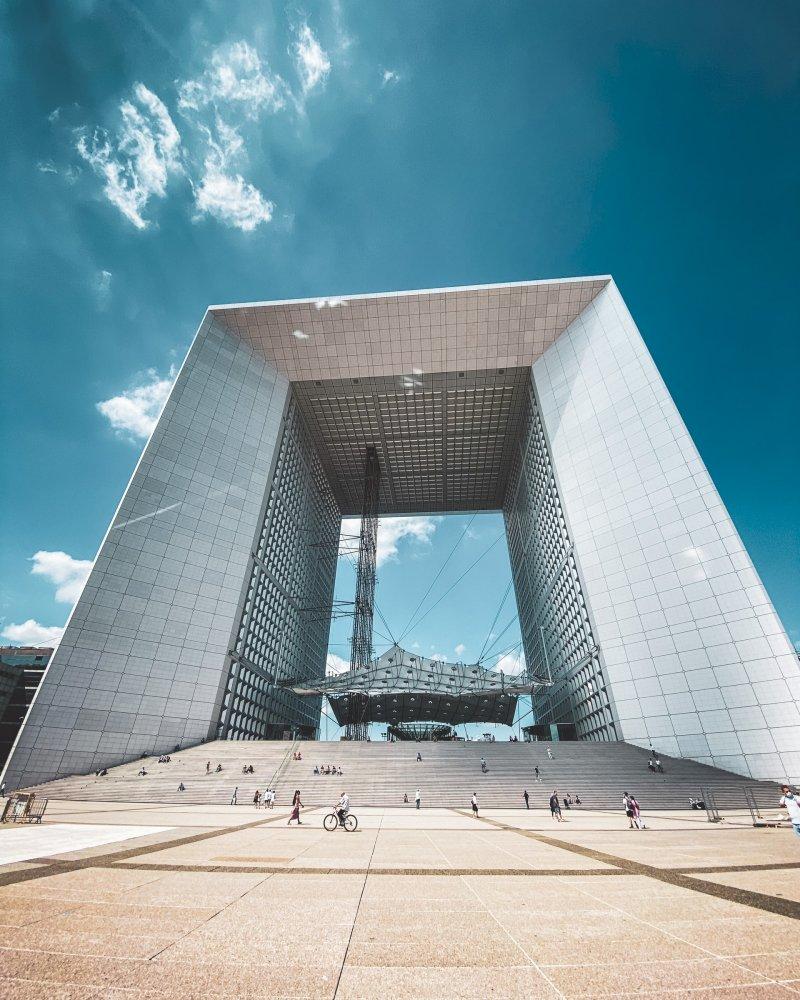
Inspired by the Arc de Triomphe, the Grande Arche is 110 meters high, 106 meters wide and 112 meters long. A huge building that will make any visitor feel tiny.
On the roof of the Grande Arche, visitors suspended between sky and land can discover a breathtaking panoramic view of the business district and the west of Paris.
22. Philharmonie de Paris
Located in the Parc de la Villette in the 19th arrondissement of Paris, the Philharmonie de Paris is the new music temple of the city.
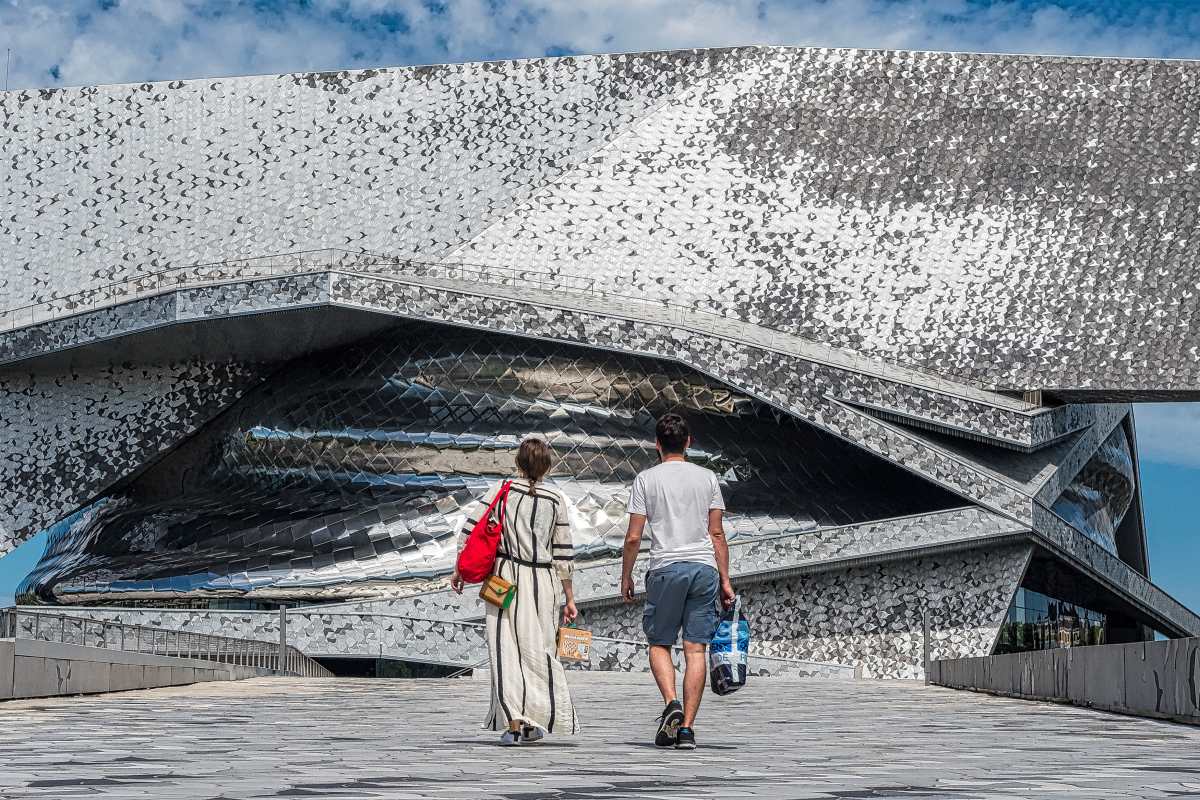
The building strikes by its atypical architecture. Built by architect Jean Novel in 2015, this auditorium is a swirl of aluminum carried by a flight of metal birds.
The Philharmonie also stands out for its exceptional acoustics, particularly in its largest room which can accommodate up to 2,400 people in orchestral configuration. On the 6th and 9th floors, visitors can access a balcony and a belvedere both offering unique views of Paris.
23. Louis Vuitton Foundation
Rising above the Bois de Boulogne in Paris like a vessel, the Louis Vuitton Foundation is a contemporary art museum and cultural center designed in 2014 by architect Frank Gehry at the request of Bernard Arnault, the CEO of LVMH.
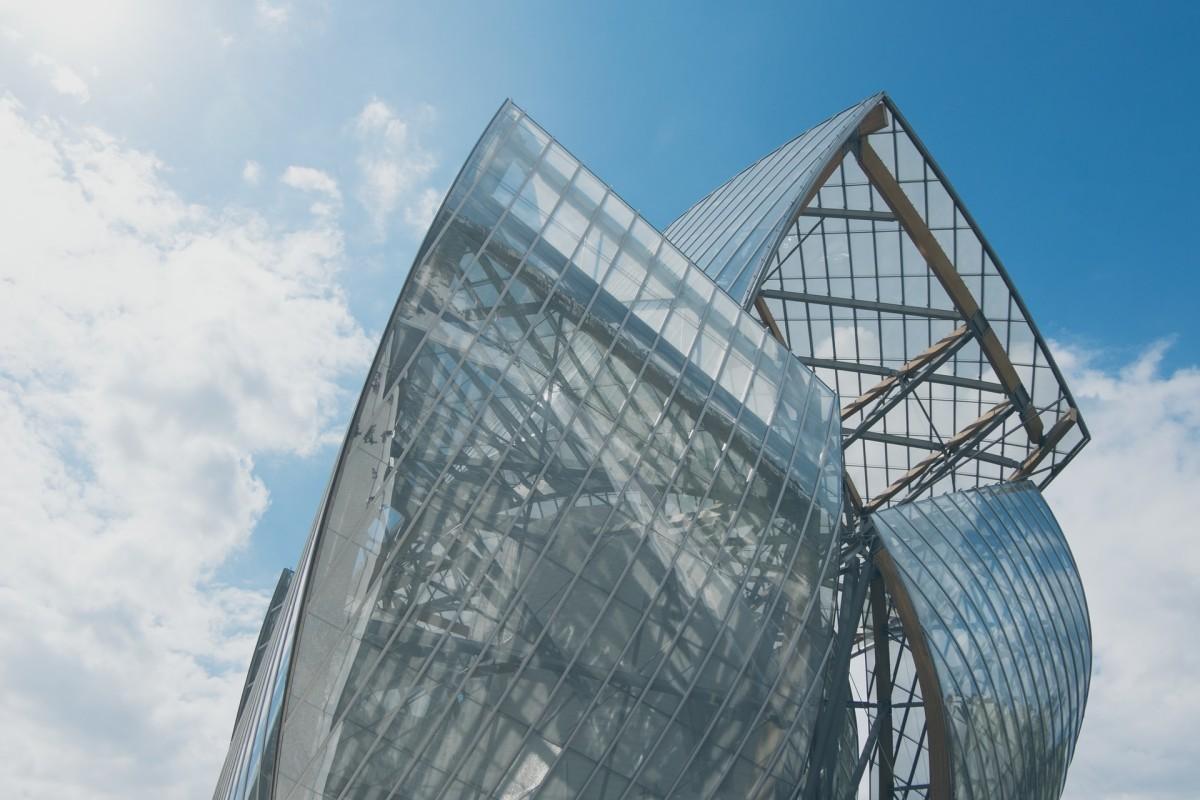
Spread over 11 galleries on 3 levels , the building houses Arnault’s important private collection, including works by Pierre Huyghe, Ellsworth Kelly, Gerhard Richter, Sarah Morris, Thomas Schütte…
When visiting the Louis Vuitton Foundation, visitors can enjoy temporary exhibitions and cultural events such as classical music and jazz concerts.
24. MUCEM
Opened in 2013, the MUCEM, or Museum of European and Mediterranean Civilizations, is a must-see site if you’re staying in Marseille.
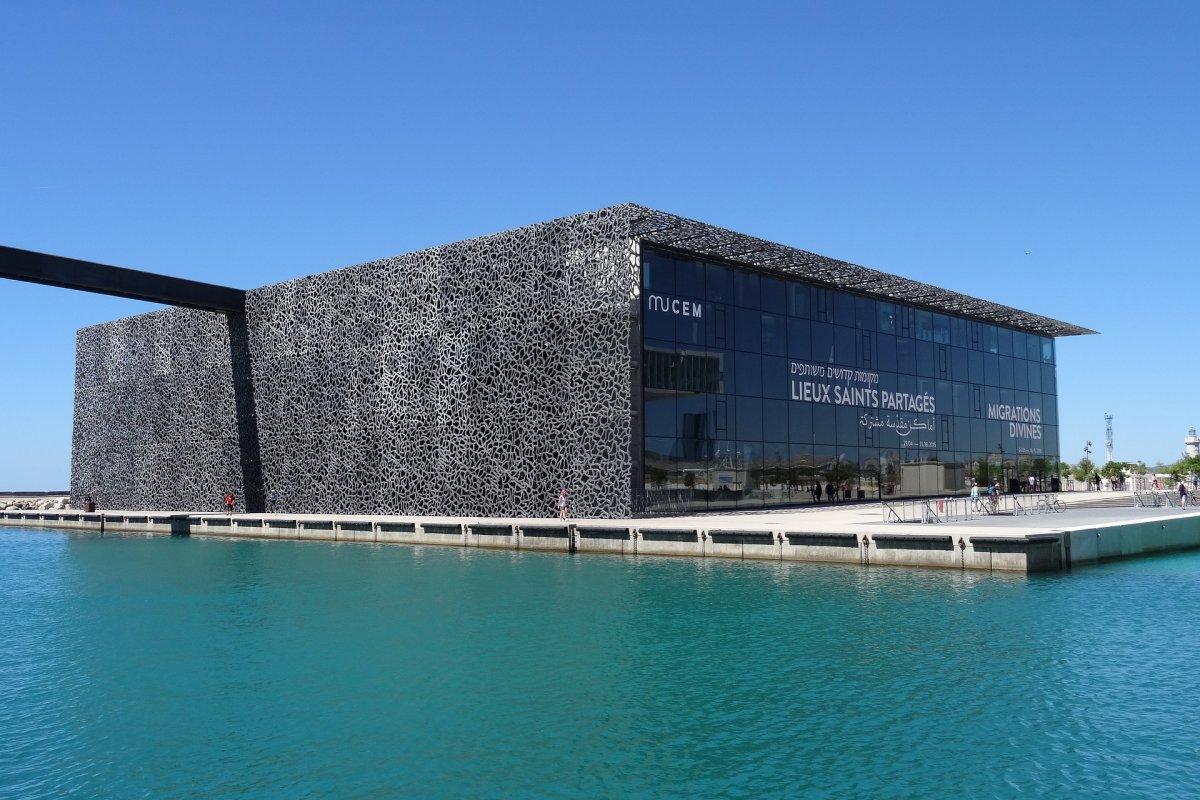
Located at the entrance of the port, you’ll be seduced at first sight by the unique architecture of the building, an impressive concrete lace cube on the waterfront that have became a famous landmark in France.
Visiting the MUCEM allows you to discover the history of European and Mediterranean civilizations. Binding together various disciplines such as anthropology, archaeology and history, visitors can discover the foundations of one of the cradles of European civilization.
Famous Natural Landmarks in France
France definitely has it all, natural landmarks included! And what is magic about France landscapes is that they’re so different you could imagine yourself in another country. From desert to heaven beaches and snowy mountains, you’ll find everything!
Let’s see 16 of the most famous natural landmarks of France! 👇
25. Lake Annecy
Considered the most beautiful and purest lake in Europe, Lake Annecy is a true natural wonder. Surrounded by mountains and overlooked by the Tournette, a peak reaching 2,351 meters, this azure colored lake is a must-see tourist spot in France.
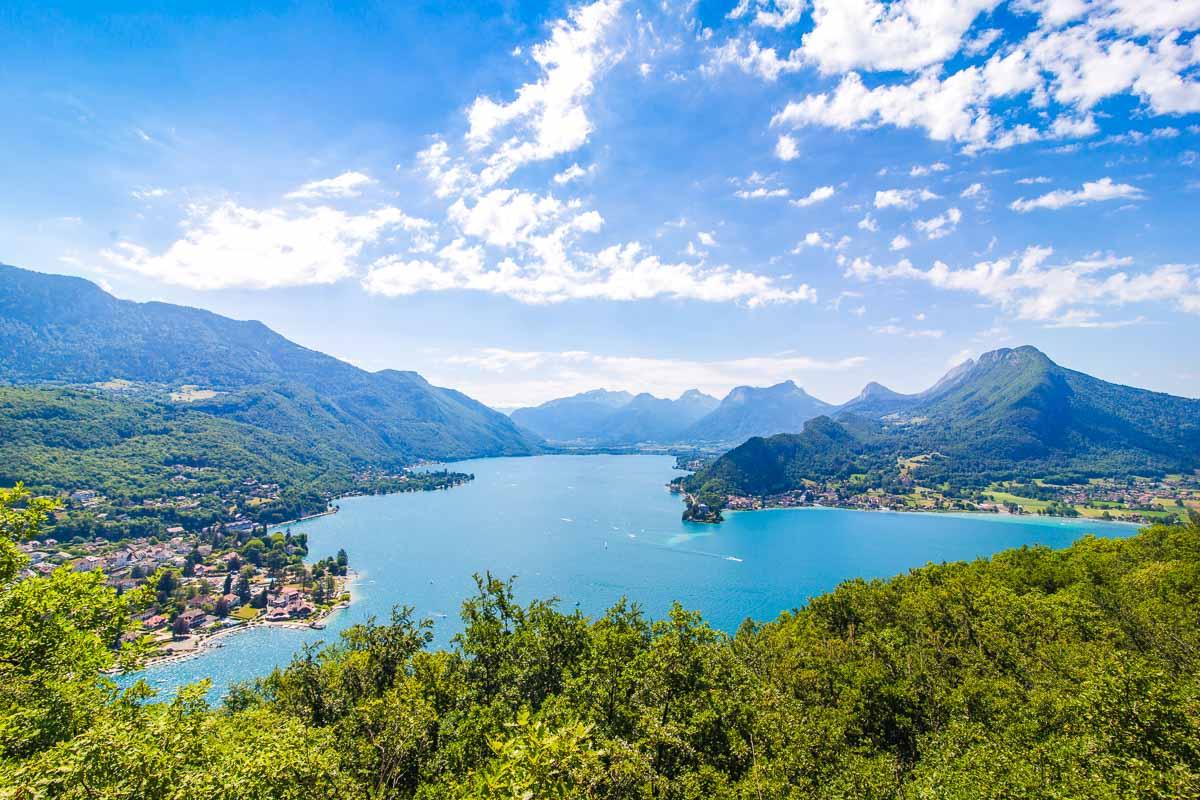
In the middle of this breathtaking landscape, tourists can do all kinds of activities. Whether on land, in the sea or in the air, there is something to do for everyone: swimming, water sports, hiking, mountain biking, paragliding, cruises, canyoning… and much more!
The city of Annecy, where the lake is located, is a mandatory stop if you’re visiting the Haute-Savoie. With its old town, its medieval castle and its canals reminding Italy’s Venice, you’ll be seduced by the charm of this city.
26. Jura Lakes & Waterfalls
Located in the east of France about 1h30 drive north from Annecy, the Jura region is called “Région des Lacs” (Lakes Region) because there’s a huge concentration of lakes, rivers, torrents and impressive waterfalls.
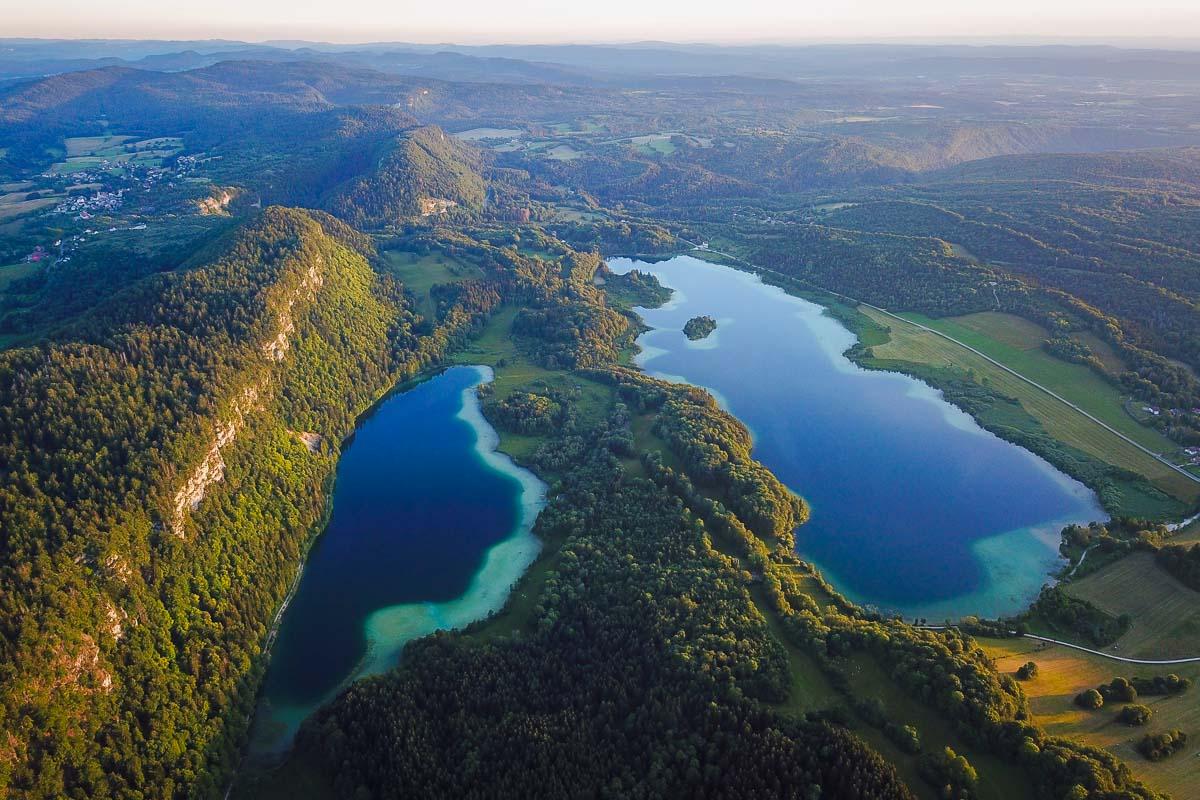
The abundance of lakes and waterfalls finds its origin in Prehistoric times and melting ice. Among the most famous lakes and waterfalls: Lac de Vouglan, Quatre Lacs, Lac de Chalan, Cascades du Hérisson…
In addition to these lakes, the Jura has many other treasures such as its mountains, its monuments, its cute villages, its gastronomy but also its well established know-how such as watchmaking. Hiking in Jura is another must-do for all nature lovers in the region.
Read more: Best Things to do in Jura
27. Mont Blanc
Located in the Alps range near the city of Chamonix, the Mont Blanc is the highest peak in Western Europe that definitely ranks in the French famous landmarks.
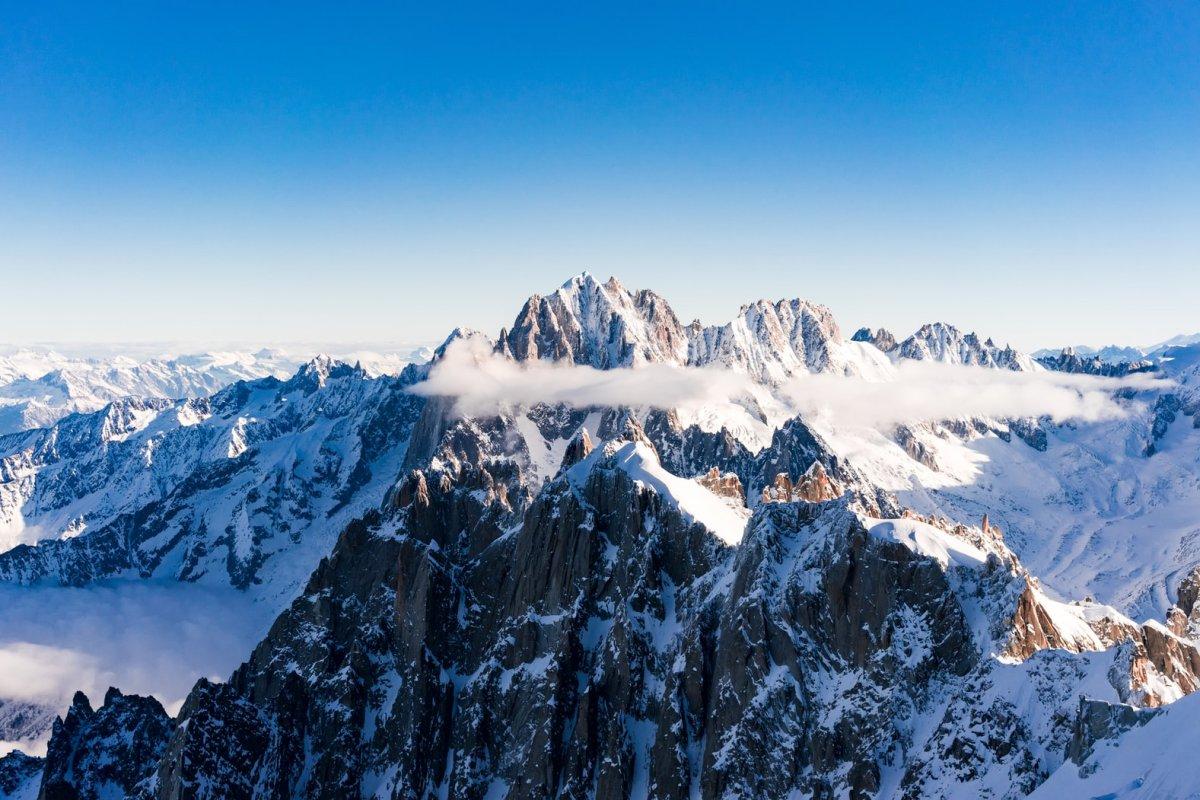
Rising to 4,809 meters above the ground, the Mont Blanc is shared between 3 countries, France, Italy and Switzerland. You can explore the Mont Blanc in Haute-Savoie and Savoie (France), in Aosta Valley (Italy) and in the canton of Valais (Switzerland).
Unless you’re an alpinist, you’ll have to go through a company that operates the lifts to access the peak. You can take one of these lifts: the cable cars of the Aiguille du Midi, the cogwheel train or the tramway. The excursion is definitely worth it, the landscape is so exceptional and breathtaking that you’ll feel dizzy.
28. Lavender Fields of Provence
Nothing better describes Provence than its immense lavender fields with their purple flowers. Among the sites where you can observe the lavender blooming, Valensole located about 1h30 drive from Marseille is the best spot, from far.
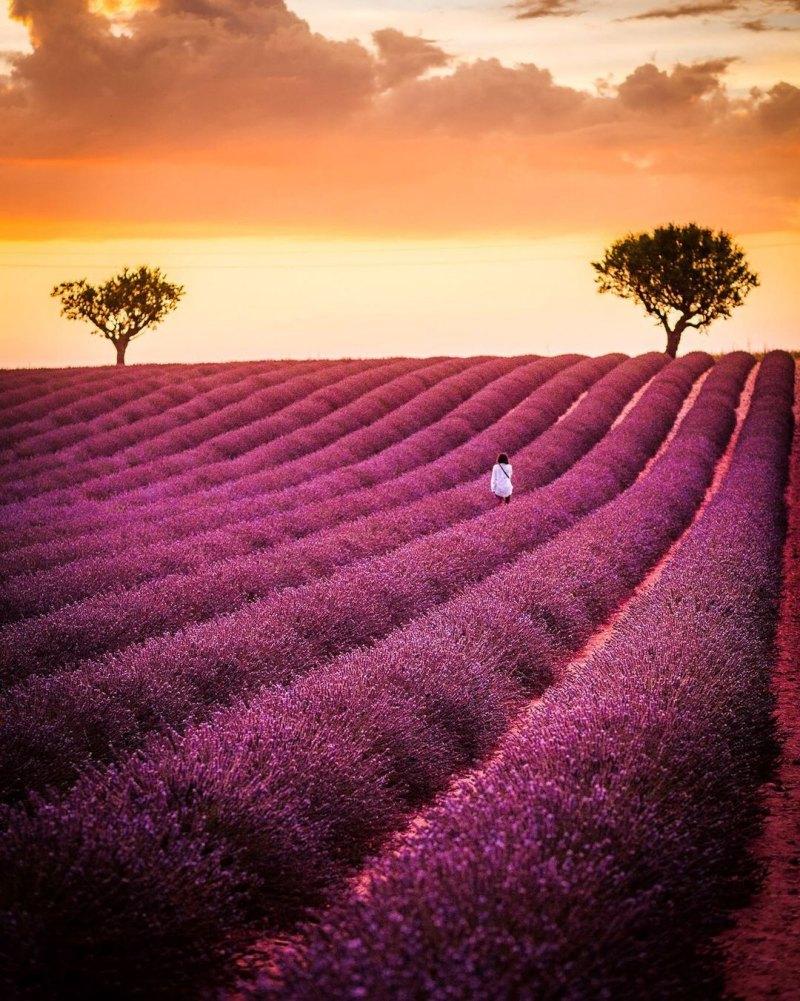
In Valensole, the lavender blooms from mid-June but it’s from July that it will reach its magnificent purple color. The best time to see the lavender fields in bloom there is between July 1st and 15th.
Covering 800 km², the plateau of Valensole will offer you lavender fields as far as the eye can see. It has become the Instagramers and tourists favorite spot and it’s often crowded.
29. Verdon Gorges
The Gorges du Verdon are among the most beautiful sites in France. It’s the largest canyon in Europe!
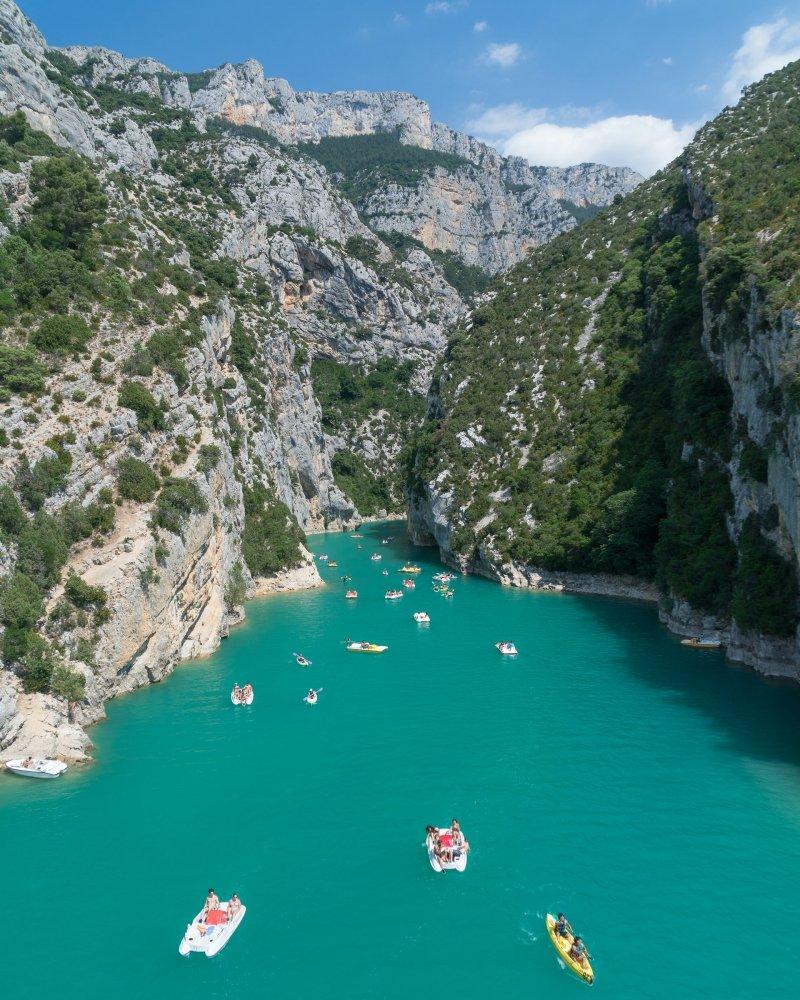
Located between Nice and Marseille, the Gorges are composed of 5 lakes: the lake of Castillon, the lake of Chaudanne, the lake of Sainte-Croix, the lake of Quinson and the lake of Esparron-de-Verdon.
The purely mineral environment made up of grey limestone and high cliffs gives the waterway an absolutely unique turquoise blue color. Wether you choose to visit the Verdon by car, to hike or to discover it by canoe, it’s a must-see and the best attraction in the South of France.
30. Calanques National Park
A turquoise sea as far as the eye can see, white fine sand and creeks lined with limestone cliffs: this is the postcard landscape that the Calanques National Park offers.
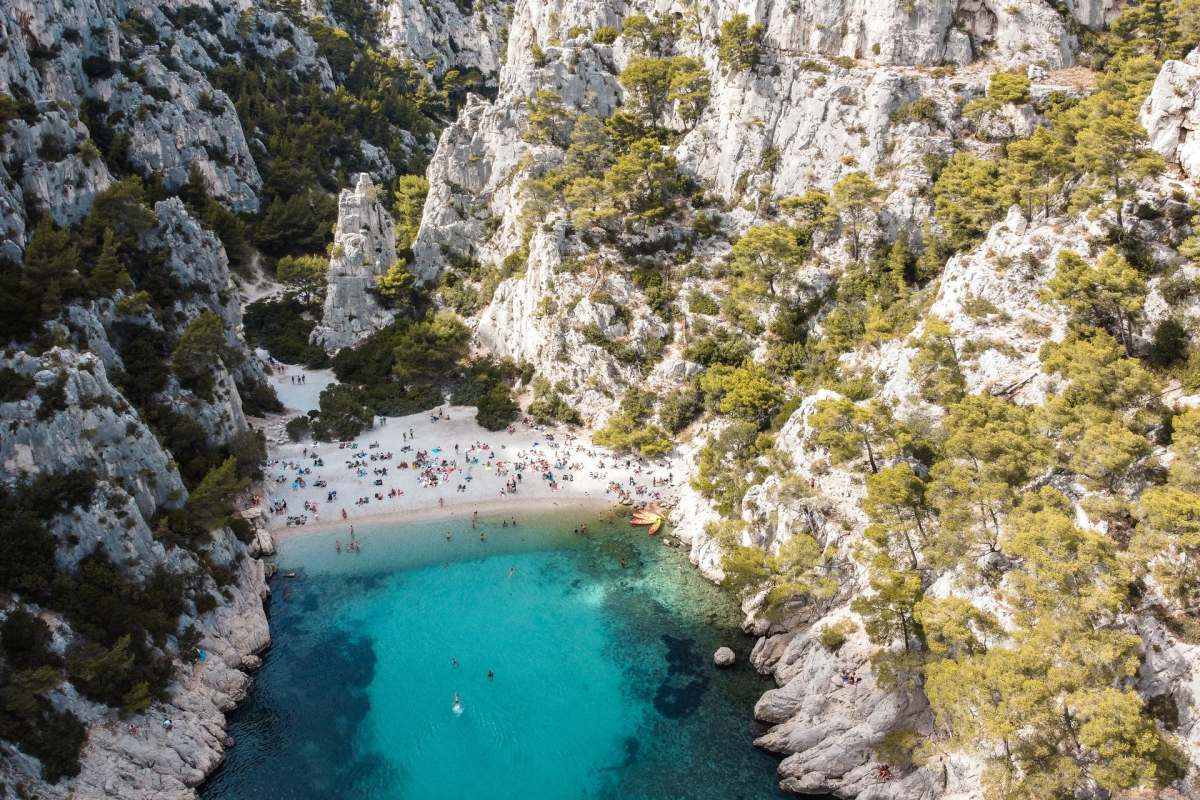
Located 30 minutes from Marseille, this national park is an emblematic site of southern France. Known throughout the world for its unique panoramas, its incredible biodiversity and its cultural heritage, it’s the only park in Europe that is both terrestrial, marine and suburban.
Composed of 26 calanques (“creek surrounded by rocks” in English), it’s the ideal place for swimming in the Mediterranean sea, hiking, kayaking or rock climbing on the cliffs. Some of the creeks are famous, such as the calanques of Port-Miou, En Vau or Sormiou.
31. The Ochre of Roussillon
Located in Roussillon, one of the most beautiful small towns in the South of France, the Ochre Trail (Le sentier des Ocres in French) looks like a Grand Canyon in the middle of Provence.
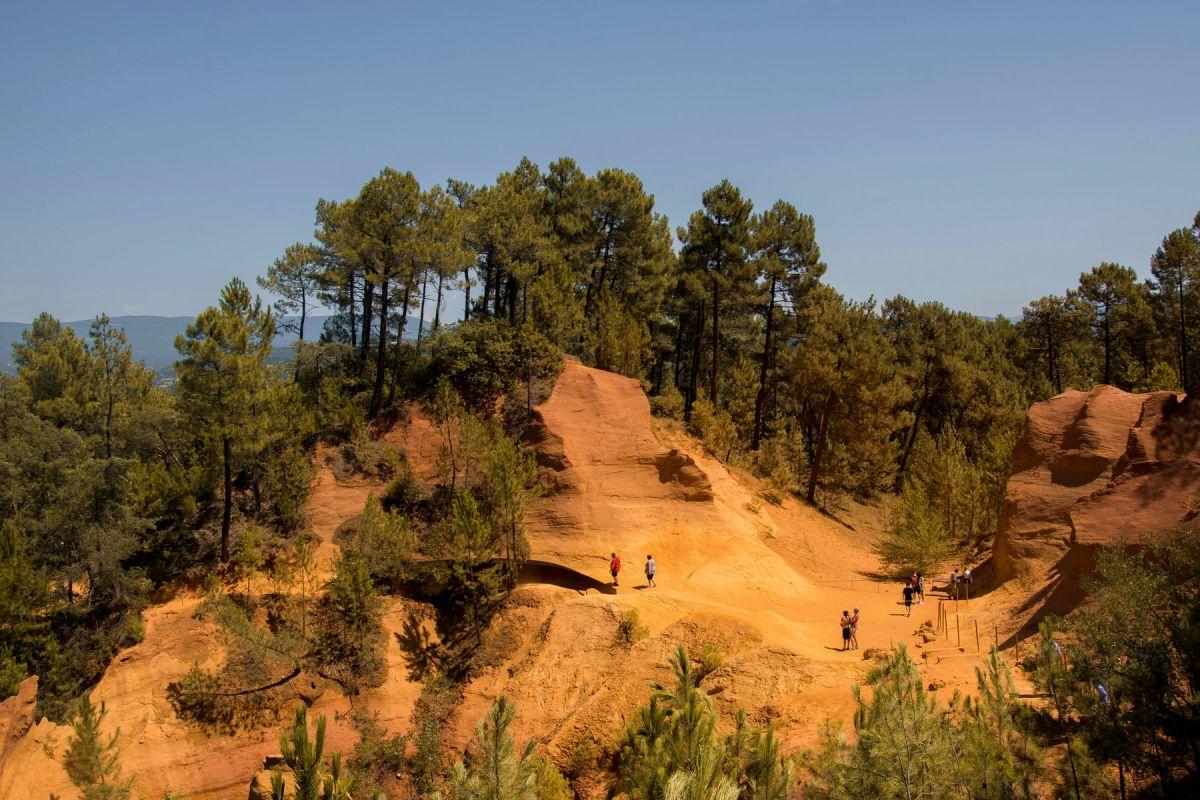
This geological curiosity is in fact a former open-air ochre quarry that is no longer exploited. The landscapes of ochreous sand with fairy chimneys and orange, yellow and red hills will offer you a unique experience.
There are 2 trails you can take to visit the Ochre, one of 30min and the other of about 1 hour. The longer trail is the tourists’ favorite because it’s the only trail that allows access to the beautiful Chaussée des Géants.
32. Camargue
Located between Montpellier and Marseille on the Mediterranean Sea, Camargue is one of the most beautiful regions of France appreciated for its wide open spaces and its wild nature which extends over more than 100,000 hectares.

In Camargue, there are many marshes, canals, rice and salt fields. But the reputation of the region mainly lies on the famous bulls and horses of Camargue in semi freedom. And of course the pink flamingos.
The region also provides beautiful monuments such as the walls Aigues-Mortes which overlooking the pink water of the Salins du Midi.
33. Dune du Pilat
Located 60 km from the city of Bordeaux on the west coast, the Dune du Pilat is the largest sand dune in Europe.
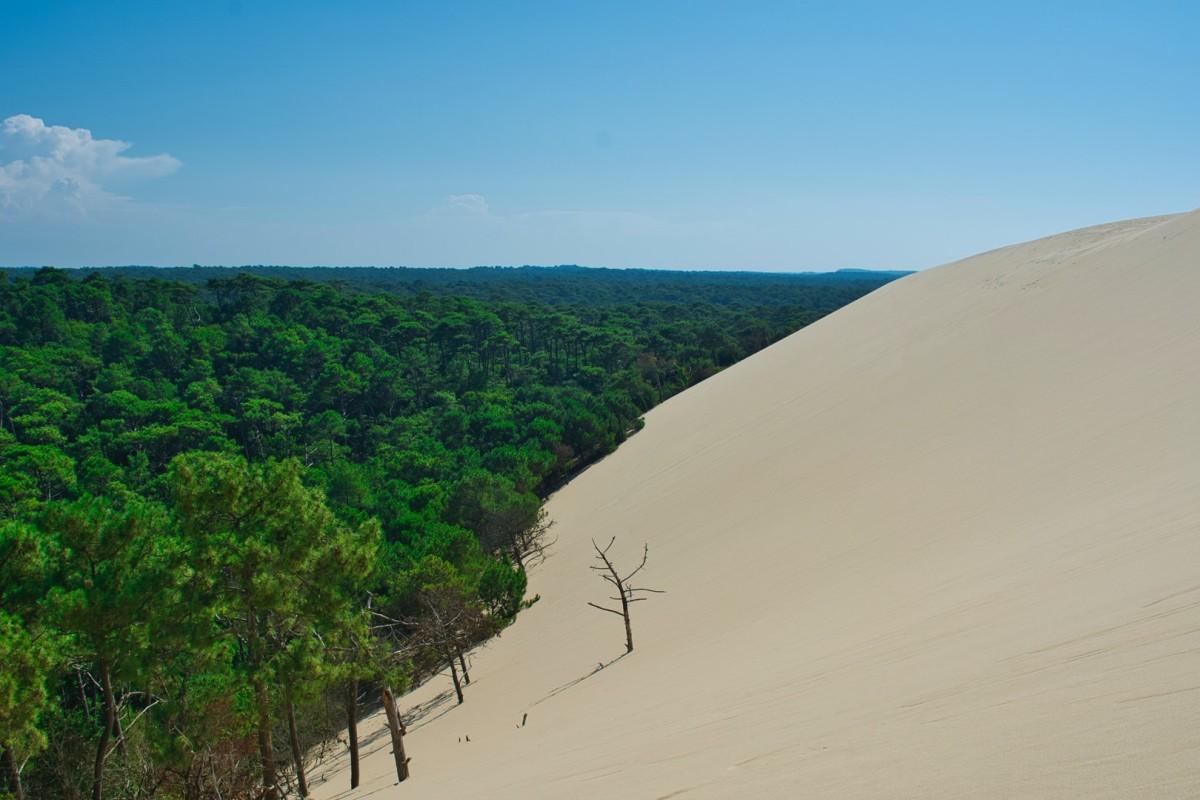
Its dimensions are incredible: the dune is more than 500 meters wide, 3 km long and reaches a height of 100-115 meters above sea level. At the top, the view is great: you can see the Atlantic coast, the vast pine forest of the Landes and even the Pyrenees range when the sky is clear.
Because of its unexpected location between sea and forest and its beauty, the dune is a very famous tourist destination in France with more than 1 million visitors every year.
34. Lascaux Cave
The Lascaux Cave is a prehistoric cave discovered in 1940 by 4 teenagers in Montignac in the region of Dordogne. The cave paintings of Lascaux are considered unique in the world.
The site, opened to the public in 1948, has unfortunately been damaged irreversibly by mass tourism. The site closed in 1963 until 1983. The caves that you can visit today are 2 replicas of a part of the cave, Lascaux II and Lascaux IV.
Listed as a World Heritage Site by UNESCO, the cave is one of the most important prehistoric decorated caves of the Paleolithic period and a priceless treasure for the history of humanity.
35. Carnac Standing Stones
On the Morbihan coast in Brittany, the town of Carnac is home to one of the most exceptional megalithic sites in the world.
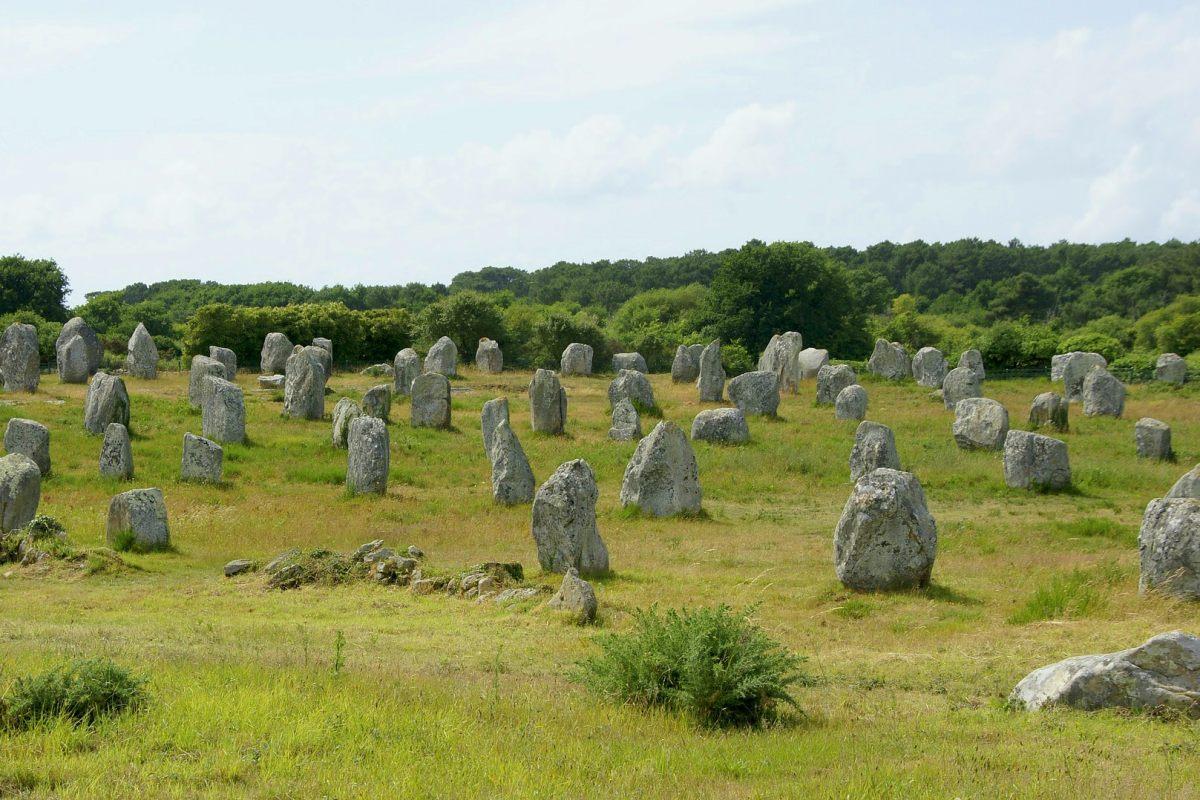
Classified as a historical monument since 1889, the Carnac alignments include nearly 3,000 menhirs over 4 km. These alignments are divided into 3 fields of megaliths: Le Ménec, Kermario and Kerlescan. Some of the menhirs are only few centimeters tall while others are huge rocks of several meters high.
Religious cult, stone army or astronomical site, the menhirs of Carnac erected between 5000 and 3000 BC still keep all their secrets.
36. Côte de Granit Rose
Also located in Brittany on the English Channel, the Pink Granite Coast owes its name to its unique geology.
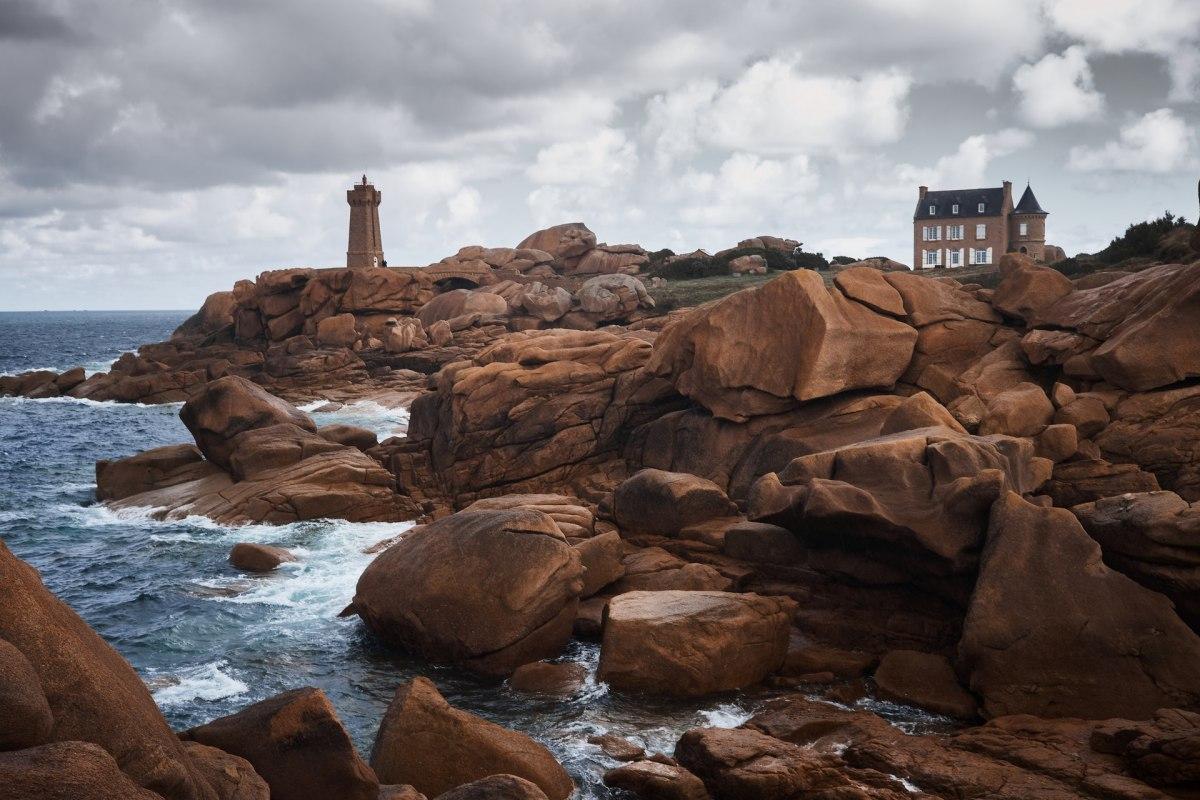
Indeed, this coastline is covered with huge pink granite stones, offering to the visitors wonderful colored panoramas. The copper and pink rocks at the water’s edge give the landscape a romantic and poetic atmosphere.
The path between the towns of Perros-Guirec and Trébeurden will offer you the most beautiful sceneries. Photographers and nature lovers rush to admire these rocks sculpted by the tide and piled up, as if they were hung in the air.
37. D-day Landing Sites
More than 75 years ago, the largest military operation of all time took place: the Allied landings of 1944. The Normandy coast in eastern France saw the landing of American, British, Canadian and other international troops who came to liberate Western Europe from the Nazis.
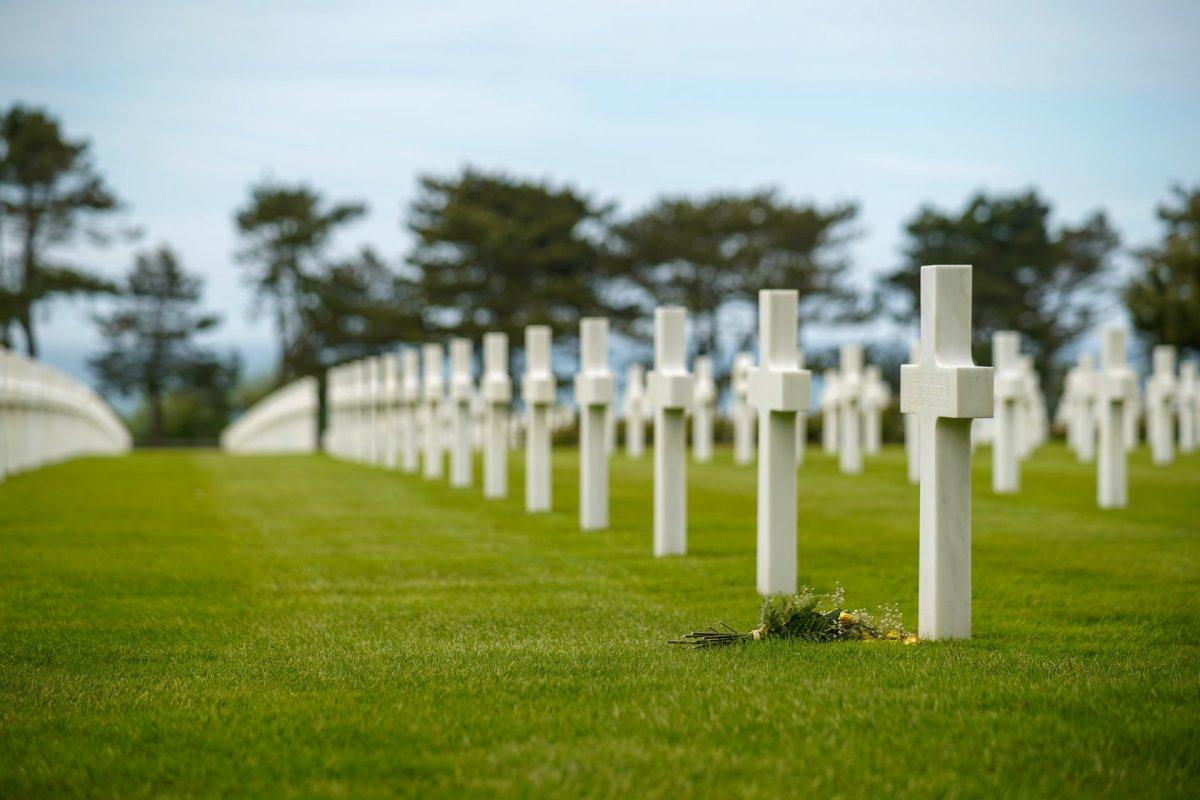
5 beaches stretching between the towns of Sainte-Mère-Eglise, Bayeux and Cabourg were chosen by the Allies and all had a code name: Utah, Omaha, Gold, Juno and Sword.
In memory of the soldiers and this operation, the D-day landing beaches now houses many memorial sites people from all over the world come to see. Among the most visited sites: Utah Beach, Omaha Beach and the American military cemetery as well as the Pointe du Hoc.
38. The Cliffs of Etretat
The Cliffs of Etretat are a must-see attraction in Normandy and one of the most visited sites in France. It’s also a top spot for glamping in France.
These cliffs are not recent since it’s estimated that they are over 100 million years old! They are chalk cliffs rising more than 102 meters above the English Channel.
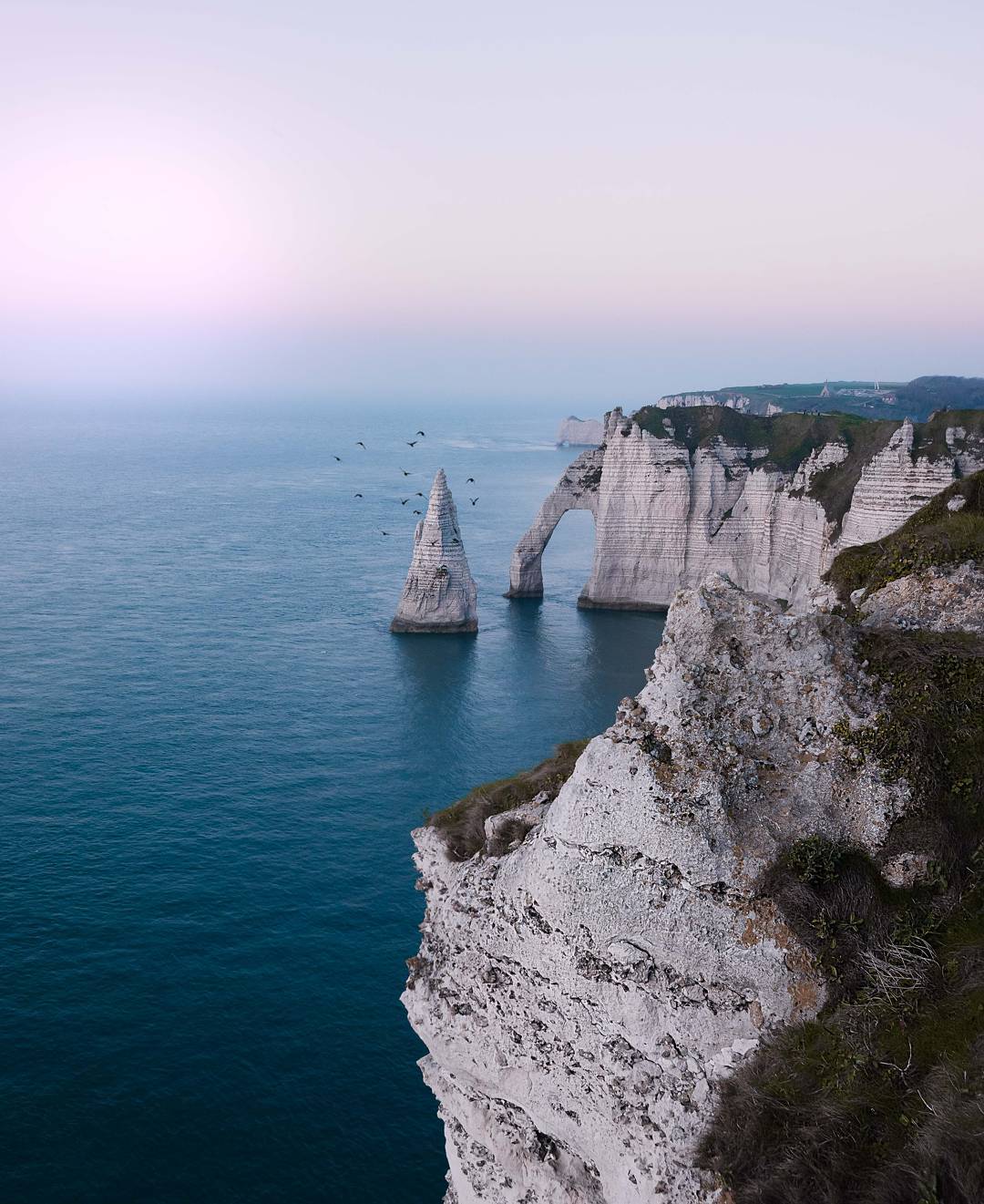
Immortalized by Monet, the view over the cliffs is one of the most beautiful, either from the sea or from the path that overlooks them. The best way to discover these cliffs is to go for a hike since you’ll be able to reach the different viewpoints, including the Manneporte or the Aiguille viewpoints.
39. Baie de Somme
Located in the north of France on the English Channel, the Somme Bay is one of the most beautiful bays in the world alongside San Francisco Bay in the USA and Halong Bay in Vietnam.

The Baie de Somme offers indeed magnificent wild landscapes rythmed by the tides. Sand beaches, pebble beaches, dunes, marshes, salt marshes, cliffs… Its beautiful and various landscapes will delight all nature lovers.
The Baie de Somme is known to be the home of the most important French colony of seals. If there’s a hike not to be missed, it’s definitely the crossing of the bay (to be done with a guide only). And if you want to discover the bay in an unusual way, you can go horseback riding in the bay.
40. Corsica Beaches
Attached to France since 1768, Corsica is the 4th largest island in the Mediterranean Sea and attracts over 3 million visitors each year because of its incredible flora.
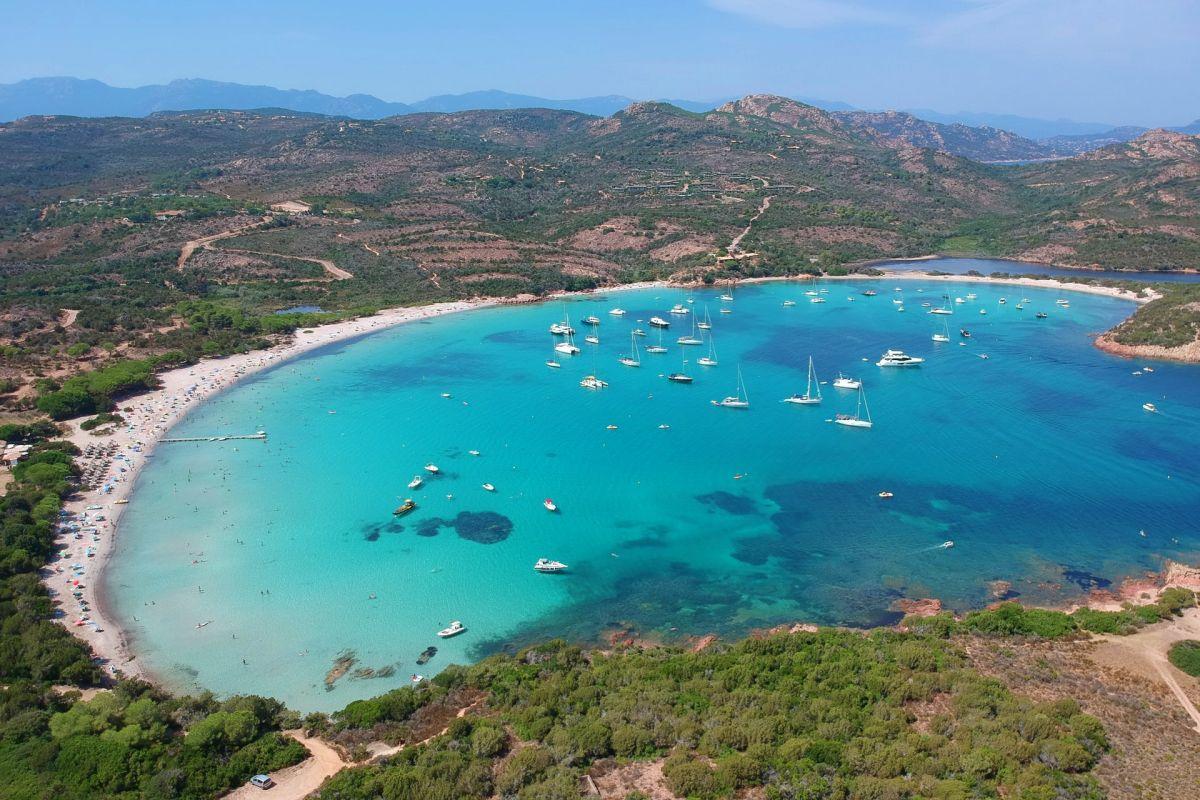
Corsica is a collection of beautiful landscapes, offering both very popular seaside resorts and stunning beaches where you can swim as in a tropical lagoon with clear, warm, turquoise or emerald waters.
Among the most beautiful beaches of the island, we can mention Palombaggia near Porto-Vecchio, Santa Giulia which is classified as a UNESCO World Heritage or La Rondinara near Bonifacio.
Congrats, you’ve been through all the 40 famous landmarks of France! 🎉
But, wait a minute before leaving! I have one free bonus below that will definitely help you, especially if you’re planning a trip to France. 😊
Map of All the Famous French Landmarks
To get the free map of all France famous landmarks, simply click on the image below to open it in Google Maps. Then click on the “star” icon to save it to your own maps.
I hope you could’ve made your list of the must-see and do in France thanks to these guides. Don’t hesitate to comment below if this is the case, I would be very pleased to read your feedback!
Loved this post? Share it with your friends by using the buttons below, I’m sure they’ll love it! 😊
Pin this to Pinterest!
Enjoyed this guide? Then help a fellow traveler and pin it! They'll most definitely love you for it, 100% guarantee.
